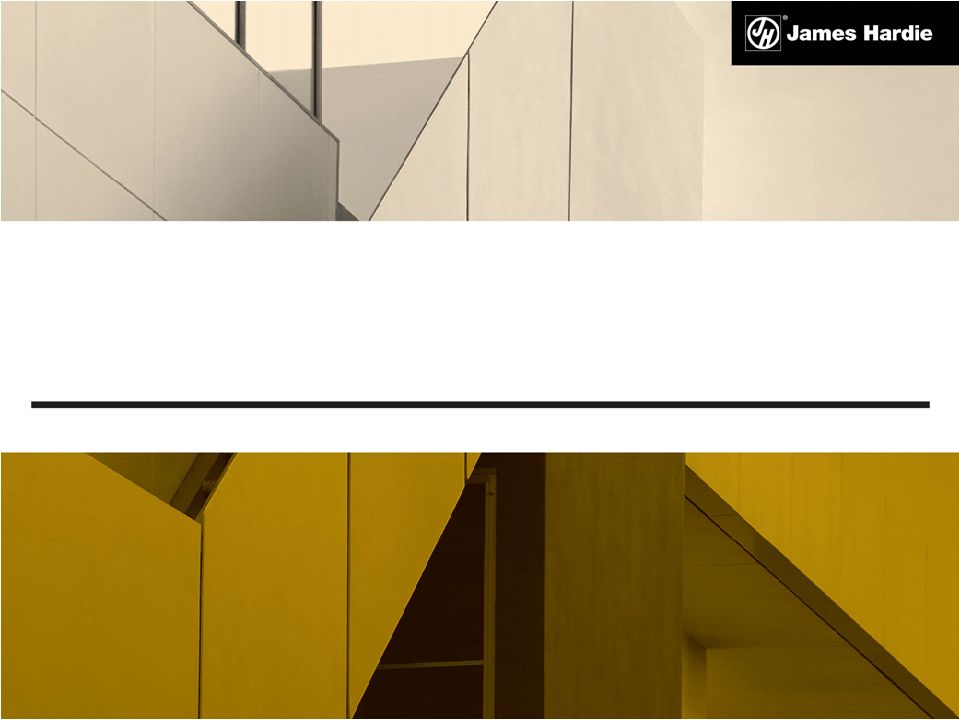 Q4 FY12
MANAGEMENT PRESENTATION 21 May 2012
Exhibit 99.4 |
 Q4 FY12
MANAGEMENT PRESENTATION 21 May 2012
Exhibit 99.4 |
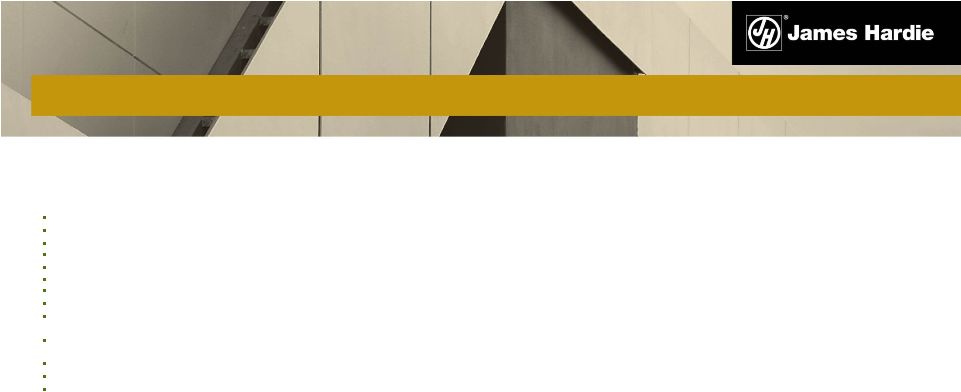 DISCLAIMER
2
This Management Presentation contains forward-looking statements. James Hardie may from time to
time make forward-looking statements in its periodic reports filed with or furnished to the
SEC, on Forms 20-F and 6-K, in its annual reports to shareholders, in offering circulars, invitation memoranda and prospectuses, in media releases and other written materials and
in oral statements made by the company’s officers, directors or employees to analysts,
institutional investors, existing and potential lenders, representatives of the media and others.
Statements that are not historical facts are forward-looking statements and such
forward-looking statements are statements made pursuant to the Safe Harbor Provisions of the Private
Securities Litigation Reform Act of 1995. Examples of forward-looking statements include: statements about the company’s future performance; projections of the company’s results of operations or financial condition; statements regarding the company’s plans, objectives or goals, including those relating to
strategies, initiatives, competition, acquisitions, dispositions and/or our products;
expectations concerning the costs associated with the suspension or closure of operations at any of
the company’s plants and future plans with respect to any such plants;
expectations that the company’s credit facilities will be extended or renewed; expectations concerning dividend payments and share buy-backs; statements concerning the company’s corporate and tax domiciles and potential changes to them,
including potential tax charges;
statements regarding tax liabilities and related audits, reviews and proceedings; statements as to the possible consequences of proceedings brought against the company and certain of
its former directors and officers by the Australian Securities and Investments Commission
(ASIC); expectations about the timing and amount of contributions to the Asbestos Injuries Compensation
Fund (AICF), a special purpose fund for the compensation of proven Australian
asbestos-related personal injury and death claims;
expectations concerning indemnification obligations; statements about product or environmental liabilities; and statements about economic conditions, such as economic or housing recovery, the levels of new home
construction, unemployment levels, changes or stability in housing values, the availability of
mortgages and other financing, mortgage and other interest rates, housing affordability and supply, the levels of foreclosures and home resales,
currency exchange rates and builder and consumer confidence. Words such as
“believe,” “anticipate,” “plan,” “expect,” “intend,” “target,” “estimate,” “project,” “predict,” “forecast,” “guideline,” “aim,”
“will,” “should,” “likely,” “continue” and similar
expressions are intended to identify forward-looking statements but are not the exclusive means of
identifying such statements. Readers are cautioned not to place undue reliance on these
forward-looking statements and all such forward-looking statements are qualified in their entirety by reference to the following cautionary statements.
Forward-looking statements are based on the company’s current expectations, estimates and
assumptions and because forward-looking statements address future results, events and
conditions, they, by their very nature, involve inherent risks and uncertainties, many of which are
unforeseeable and beyond the company’s control. Such known and unknown risks,
uncertainties and other factors may cause actual results, performance or other achievements to differ
materially from the anticipated results, performance or achievements expressed, projected or
implied by these forward-looking statements. These factors, some of which are discussed under “Risk Factors” in Section 3 of the Form 20-F filed with the US Securities and
Exchange Commission on 29 June 2011, as amended by the Form 20-F/A filed on 14 July 2011,
include, but are not limited to: all matters relating to or arising out of the prior
manufacture of products that contained asbestos by current and former James Hardie subsidiaries;
required contributions to the AICF, any shortfall in the AICF and the effect of currency
exchange rate movements on the amount recorded in the company’s financial statements as an
asbestos liability; governmental loan facility to the AICF; compliance with and changes in tax
laws and treatments; competition and product pricing in the markets in which the company operates; the consequences of product failures or defects; exposure to environmental,
asbestos or other legal proceedings; general economic and market conditions; the supply and cost of
raw materials; possible increases in competition and the potential that competitors could copy
the company’s products; reliance on a small number of customers; a customer’s inability to pay; compliance with and changes in environmental and health and safety laws;
risks of conducting business internationally; compliance with and changes in laws and regulations; the
effect of the transfer of the company’s corporate domicile from The Netherlands to Ireland
to become an Irish SE including employee relations, changes in corporate governance and potential tax benefits; currency exchange risks; dependence on customer preference
and the concentration of the company’s customer base on large format retail customers,
distributors and dealers; dependence on residential and commercial construction markets; the
effect of adverse changes in climate or weather patterns; possible inability to renew credit
facilities on terms favorable to the company, or at all; acquisition or sale of businesses and
business segments; changes in the company’s key management personnel; inherent limitations on
internal controls; use of accounting estimates; and all other risks identified in the
company’s reports filed with Australian, Irish and US securities agencies and exchanges (as
appropriate). The company cautions you that the foregoing list of factors is not exhaustive and
that other risks and uncertainties may cause actual results to differ materially from those in forward-looking statements. Forward-looking statements speak only as of the date they
are made and are statements of the company’s current expectations concerning future results,
events and conditions. |
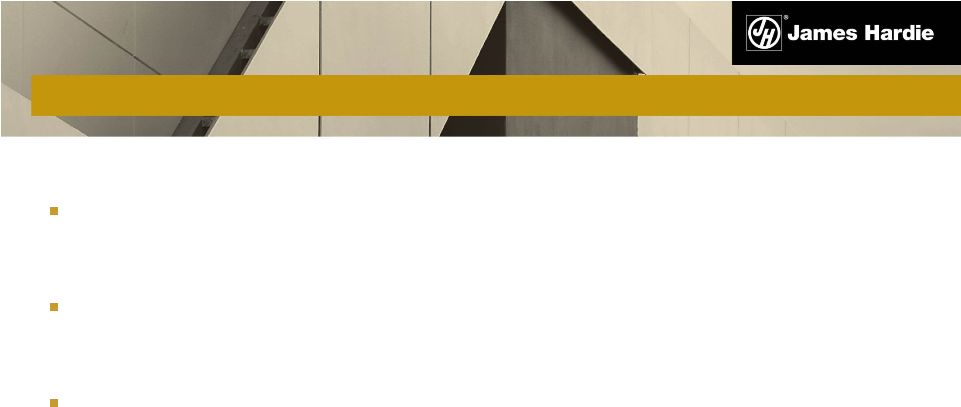 AGENDA
Overview and Operating Review –
Louis Gries, CEO
Financial Review –
Russell Chenu, CFO
Questions and Answers
3
In this
Management
Presentation,
James
Hardie
may
present
financial
measures,
sales
volume
terms,
financial
ratios,
and
Non-US
GAAP
financial
measures included in the Definitions section of this document starting on page 51.
The company presents financial measures that it believes are customarily
used by its Australian investors. Specifically, these financial measures, which are equivalent to or derived from certain US GAAP
measures
as
explained
in
the
definitions,
include
“EBIT”,
“EBIT
margin”,
“Operating
profit”
and
“Net
operating
profit”.
The
company
may
also
present
other
terms
for
measuring
its
sales
volumes
(“million
square
feet”
or
“mmsf”
and
“thousand
square
feet”
or
“msf”);
financial
ratios
(“Gearing
ratio”,
“Net
interest expense cover”, “Net interest paid cover”, “Net debt
payback”, “Net debt (cash)”); and Non-US GAAP financial measures (“EBIT excluding
asbestos, asset impairments and ASIC expenses”, “EBIT margin excluding
asbestos, asset impairments and ASIC expenses”, “Net operating profit
excluding asbestos, asset impairments, ASIC expenses and tax adjustments”,
“Diluted earnings per share excluding asbestos, asset impairments, ASIC
expenses, and tax adjustments”, “Operating profit before income taxes excluding asbestos and asset impairments”, “Effective tax rate excluding
asbestos,
asset
impairments
and
tax
adjustments”,
“EBITDA”
and
“General
corporate
costs
excluding
ASIC
expenses
and
domicile
change
related
costs”). Unless otherwise stated, results and comparisons are of the 4th
quarter and full year of the current fiscal year versus the 4th quarter and full
year of the prior fiscal year. |
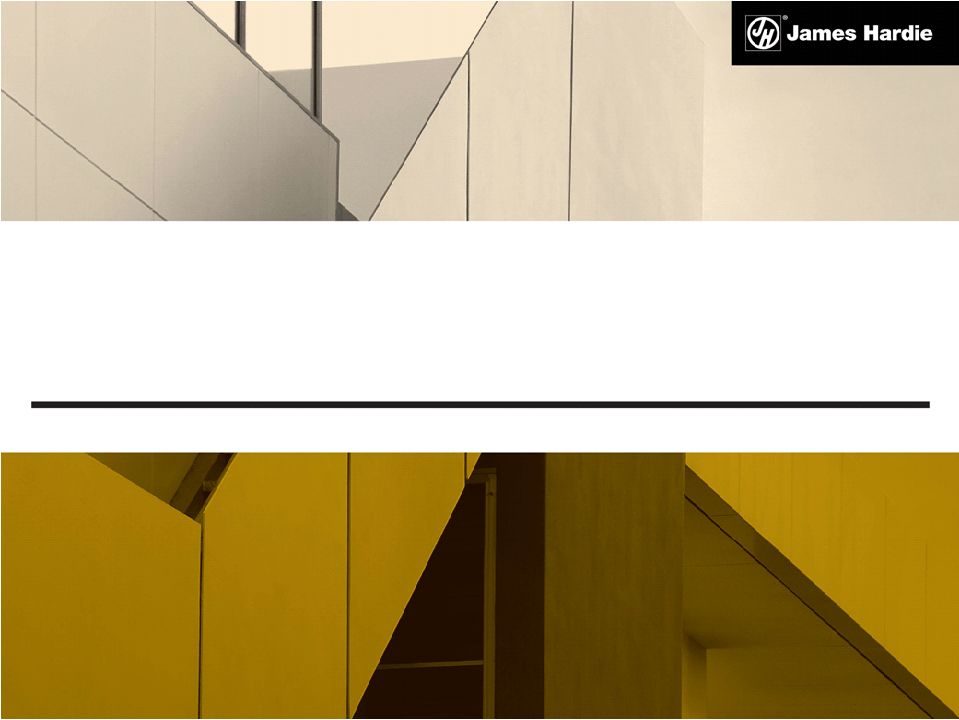 OPERATING
REVIEW Louis Gries, CEO |
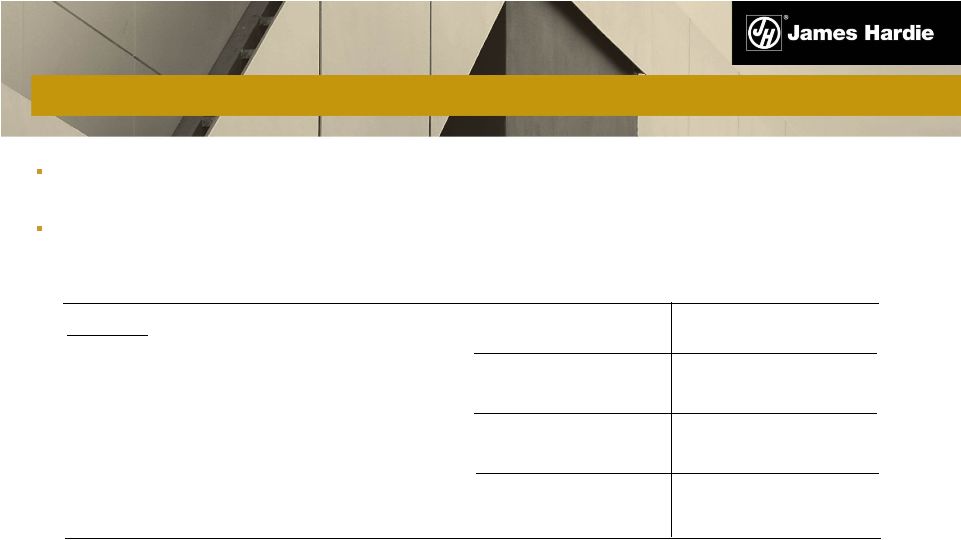 5
The net operating result excluding asbestos, ASIC expenses, asset impairments and
tax adjustments for the full year increased 20% to US$140.4
million The 4th quarter and full year results include an income
tax benefit of US$485.2 million resulting from RCI’s successful appeal
of the ATO’s 1999 disputed amended assessment 1
Comparisons
are
of
the
4th
quarter
and
full
year
of
the
current
fiscal
year
versus
the
4th
quarter
and
full
year
of
the
prior
fiscal
year
2
The 4
th
quarter and full year results of the current fiscal year include an income tax
benefit of US$485.2 million resulting primarily from amounts
refunded
by
the
ATO
and
reversal
of
the
provision
for
the
unpaid
amended
assessment
in
relation
to
RCI’s
appeal
that
finalised
in
RCI’s
favour.
Prior
year included a charge of US$345.2 million resulting from the dismissal by the
Federal Court of Australia of RCI’s appeal of the ATO’s disputed 1999
assessment. Readers are referred to Note 14 of the consolidated financials for
further information Q4
Q4
%
%
FY 2012
FY 2011 Change
FY 2012
FY 2011 Change
Net operating profit (loss)
2
480.7
(1.8)
-
604.3
(347.0)
-
Net operating profit excluding asbestos, asset
impairments, ASIC expenses and tax adjustments
32.1
33.3
(4)
140.4
116.7
20
Diluted earnings per share excluding asbestos, asset
impairments, ASIC expenses and tax adjustments (US cents)
7.3
7.6
(4)
32.1
26.7
20
US$ Millions
GROUP OVERVIEW
1 |
 USA AND
EUROPE FIBRE CEMENT 4th Quarter Result
Net Sales
up
12% to US$220.7
million
Sales Volume
up
14% to 351.2 mmsf
Average Price
down
2% to US$628 per msf
EBIT
down
5% to US$36.4 million
EBIT Margin
down
3.0 pts to 16.5%
6
1
Comparisons are of the 4th quarter of the current fiscal year versus the 4th quarter of the prior
fiscal year 2
Excludes impairment charge of US$14.3 million
2
2
1 |
 USA AND
EUROPE FIBRE CEMENT Full Year Result
Net Sales
up
6% to US$862.0
million
Sales Volume
up
7% to 1,331.8 mmsf
Average Price
down
1% to US$647 per msf
EBIT
up
1% to US$162.7 million
EBIT Margin
down
0.8 pts to 18.9%
7
1
Comparisons are of the full year of the current fiscal year versus the full year of the prior fiscal
year 2
Excludes impairment charge of US$14.3 million
2
2
1 |
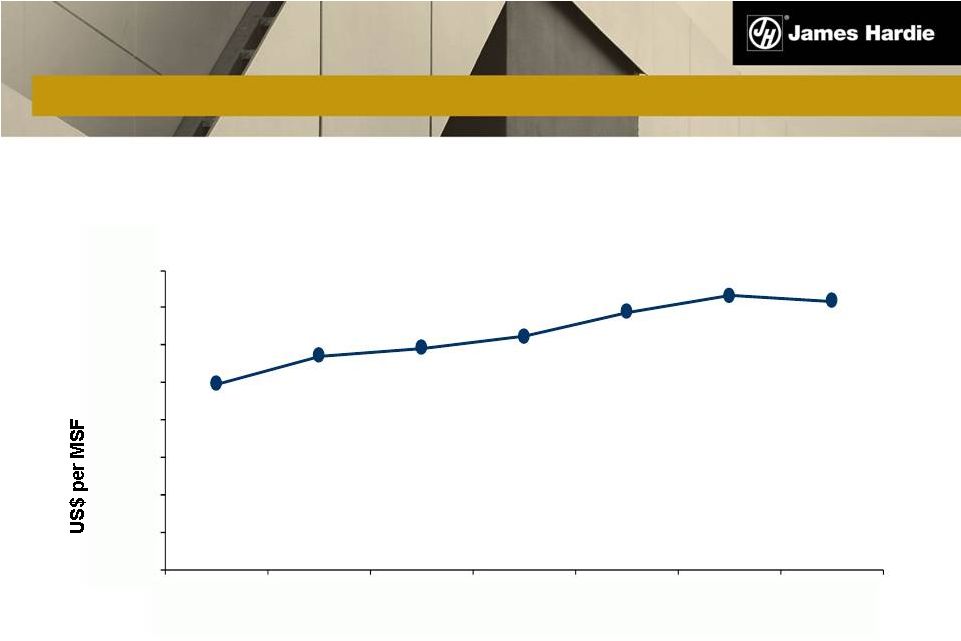 USA AND
EUROPE FIBRE CEMENT Average Net Sales Price (US dollars)
US$647
360
400
440
480
520
560
600
640
680
FY06
FY07
FY08
FY09
FY10
FY11
FY12
8 |
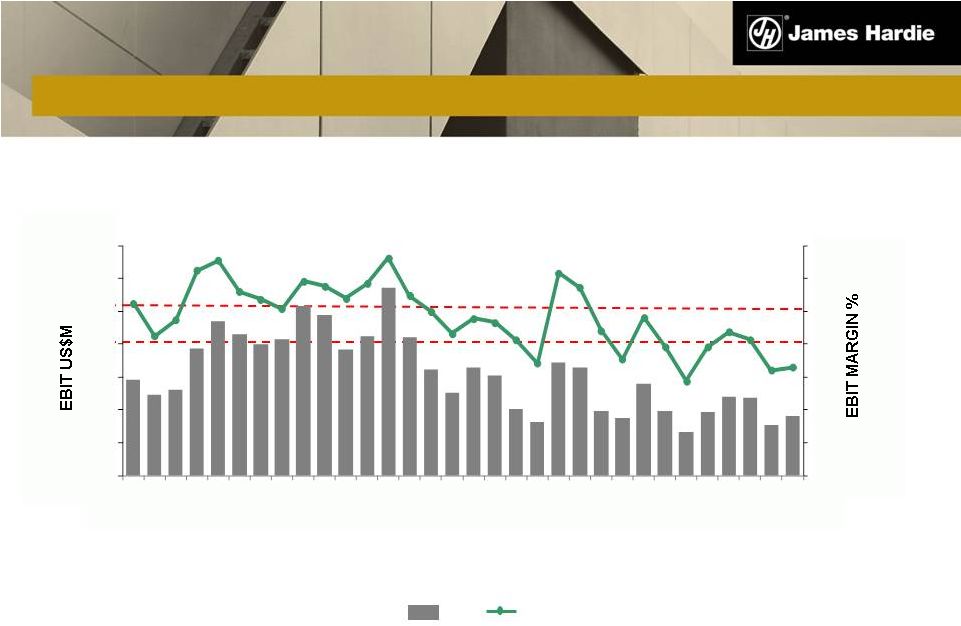 1
Excludes impairment charges of US$45.6 million in Q4 FY08 and US$14.3
million in Q4 FY12 9
EBIT
and
EBIT
Margin
1
EBIT
EBIT Margin
USA AND EUROPE FIBRE CEMENT
0
5
10
15
20
25
30
35
0
20
40
60
80
100
120
140
FY05
FY06
FY07
FY08
FY09
FY10
FY11
FY12 |
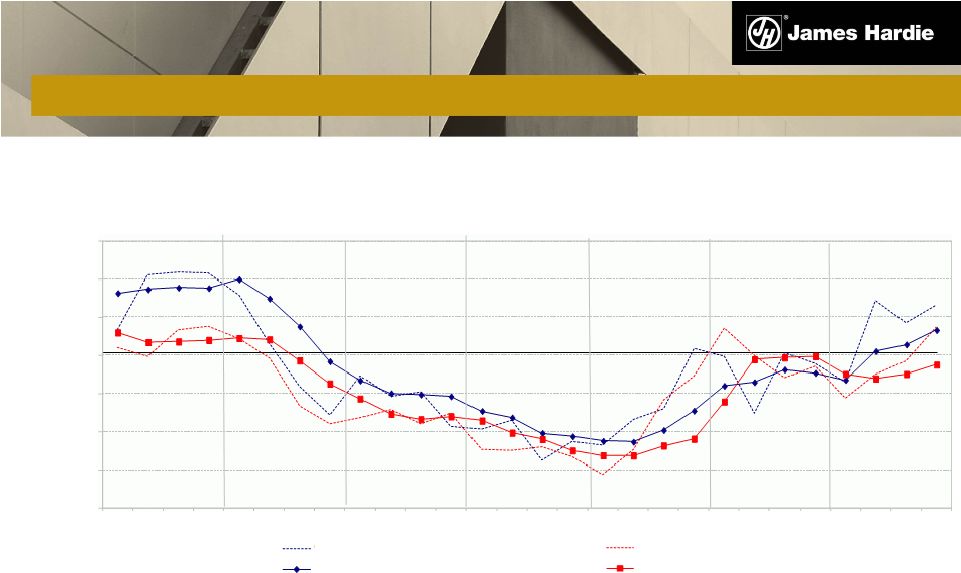 Primary Growth Performance
All market and market share figures are management‘s estimates.
10
USA AND EUROPE FIBRE CEMENT
-40%
-30%
-20%
-10%
0%
10%
20%
30%
Q106
Q206
Q306
Q406
Q107
Q207
Q307
Q407
Q108
Q208
Q308
Q408
Q109
Q209
Q309
Q409
Q110
Q210
Q310
Q410
Q111
Q211
Q311
Q411
Q112
Q212
Q312
Q412
%JHBP Growth (sdft)
NC/R&R Growth
Rolling 4Qtr -
JHBP Growth (sdft)
Rolling 4Qtr -
NC/R&R Growth |
 ASIA
PACIFIC FIBRE CEMENT 4th Quarter Result
Net Sales
down
2% to US$88.6
million
Sales Volume
down
8% to 94.1 mmsf
Average Price
up
1% to A$891 per msf
EBIT
down
26% to US$14.3 million
EBIT Margin
down
5.3 pts to 16.1%
11
1
Comparisons are of the 4th quarter of the current fiscal year versus the 4th
quarter of the prior fiscal year 1 |
 ASIA
PACIFIC FIBRE CEMENT Full Year Result
Net Sales
up
6% to US$375.5
million
Sales Volume
down
4% to 392.3 mmsf
Average Price
flat
at A$916 per msf
EBIT
up
1% to US$80.3 million
EBIT Margin
down
1.1 pts to 21.4%
12
1
Comparisons are of the full year of the current fiscal year versus the full year of the prior fiscal
year 1 |
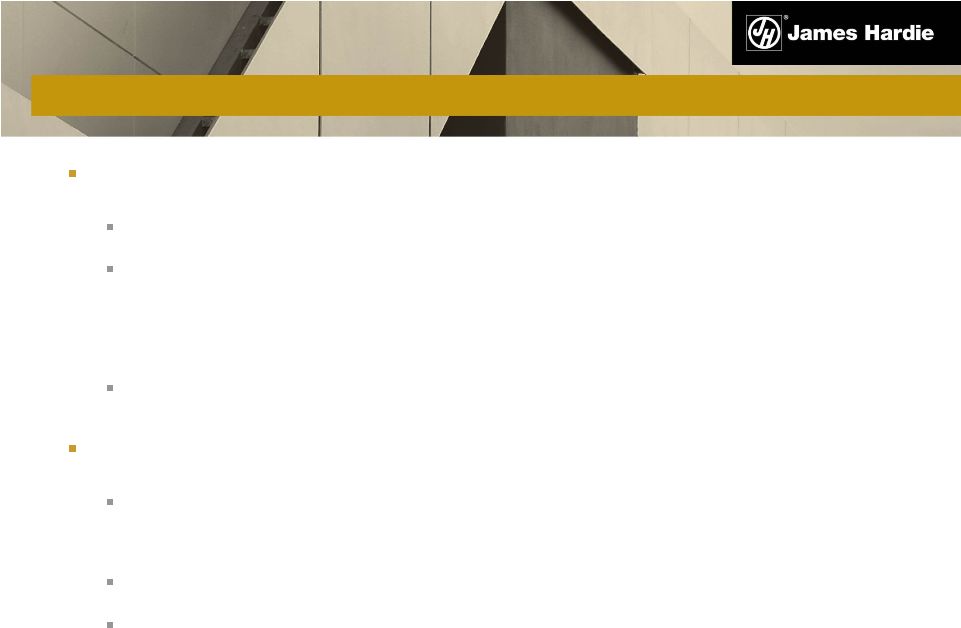 GROUP
4 th
QUARTER SUMMARY
13
1
Comparisons are of the 4th quarter of the current fiscal year versus the 4th
quarter of the prior fiscal year USA and Europe Fibre Cement results
reflected: Demand stabilising at levels above last year
Lower
average
net
sales
price
and
higher
fixed
manufacturing
and
organisational
costs,
partially
offset
by
higher
sales
volume,
some
lower
input
costs
and
improved
plant performance
Market and category share gains
Asia Pacific Fibre Cement results reflected:
Weak operating environments in the Asia Pacific region, particularly Australia and
New Zealand
Lower sales volume and higher input costs
Partially offset by price increases
1 |
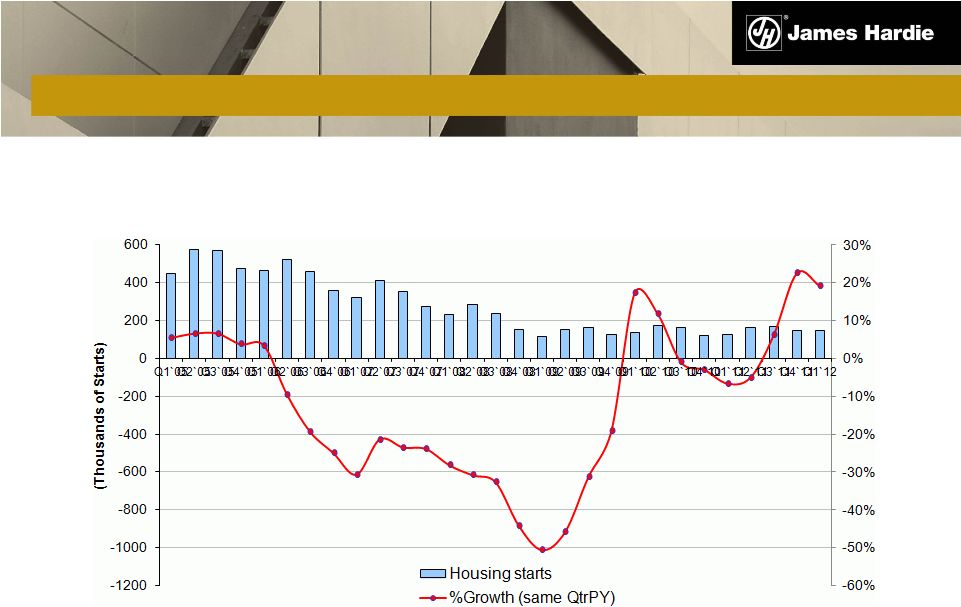 TOTAL
USA HOUSING STARTS – US CENSUS
14
Source: US Census Bureau -
New Privately-Owned Housing Units Started
U.S. Housing Starts
Calendar Quarters |
 15
GROUP OUTLOOK
United States
While some encouraging industry data points emerged during the final quarter of
the 2012 financial year, the company is planning for the market to be up
only slightly over the prior year
Pulp
and
freight
costs
are
expected
to
remain
at
elevated
levels
when
compared
to
historic
long-term
averages
Company
initiatives,
such
as
increased
penetration
in
repair
and
remodel,
and
our
Colorplus, non-metro markets and job pack strategies, are on track to continue
our positive primary demand growth
Asia Pacific
Australia: notwithstanding the softening operating environment, the Australian
business remains positioned to continue to win market and category
share New Zealand: activity in the housing construction industry remains
subdued |
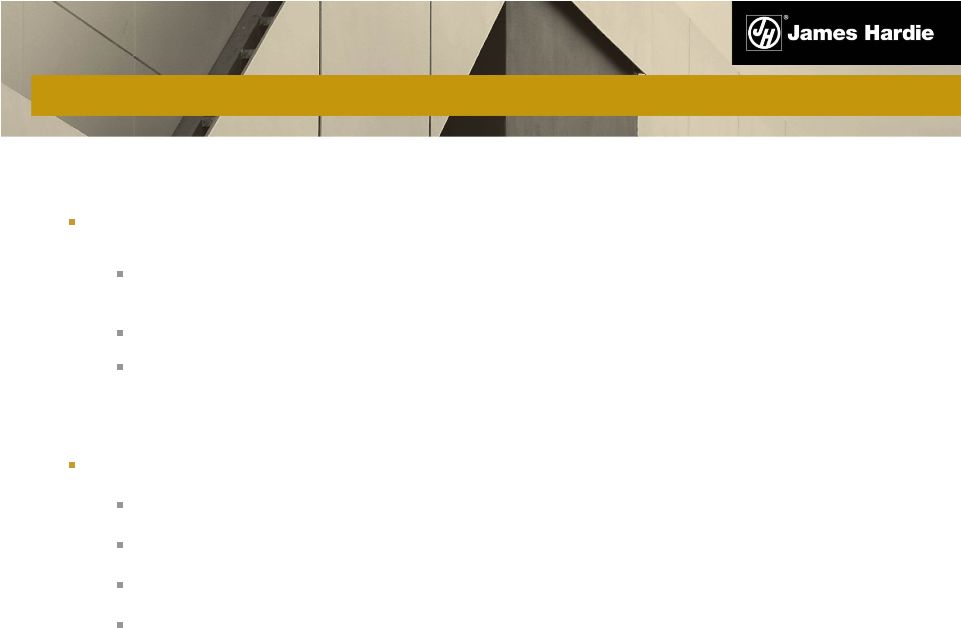 16
GROUP OUTLOOK
Key Priorities
The company’s key medium term priorities in the US are:
Grow
primary
demand
and
exterior
cladding
market
share
–
with
focus
on
repair
and remodel and non-metro markets
Increase
market
penetration
of
our
ColorPlus
®
and
Trim
products
Continue to rollout our job pack distribution model
Overall Group Strategy
The company’s focus is to:
Deliver primary demand growth
Continue to shift to a higher value product mix
Increase manufacturing efficiency
Build the operational strength and flexibility to deliver and sustain earnings in
a low demand environment and increase output should a stronger than
expected recovery eventuate |
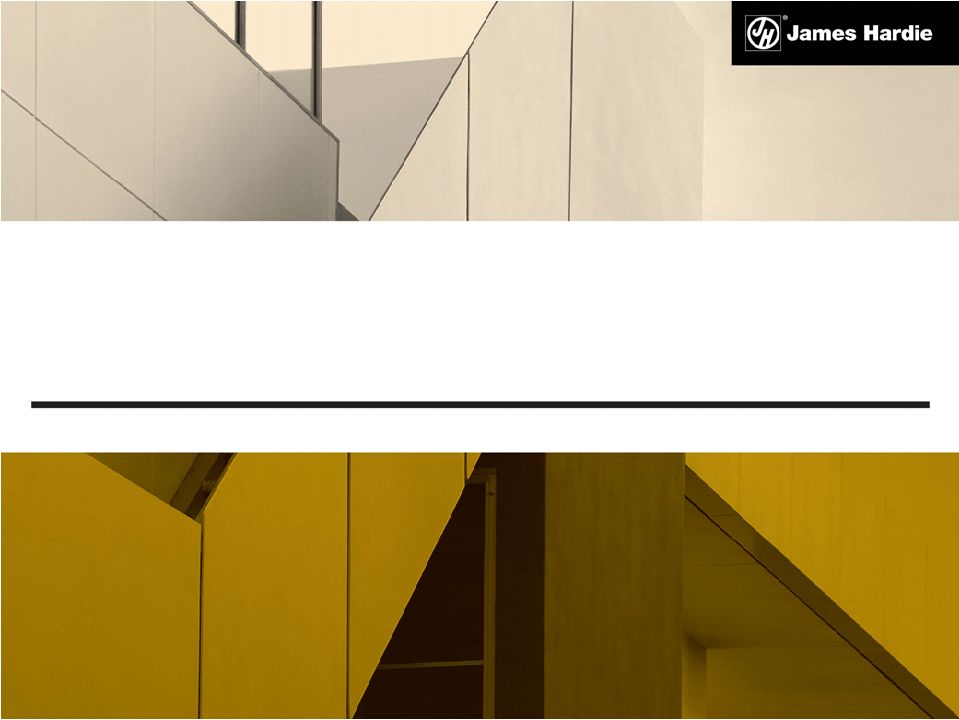 FINANCIAL REVIEW
Russell Chenu, CFO |
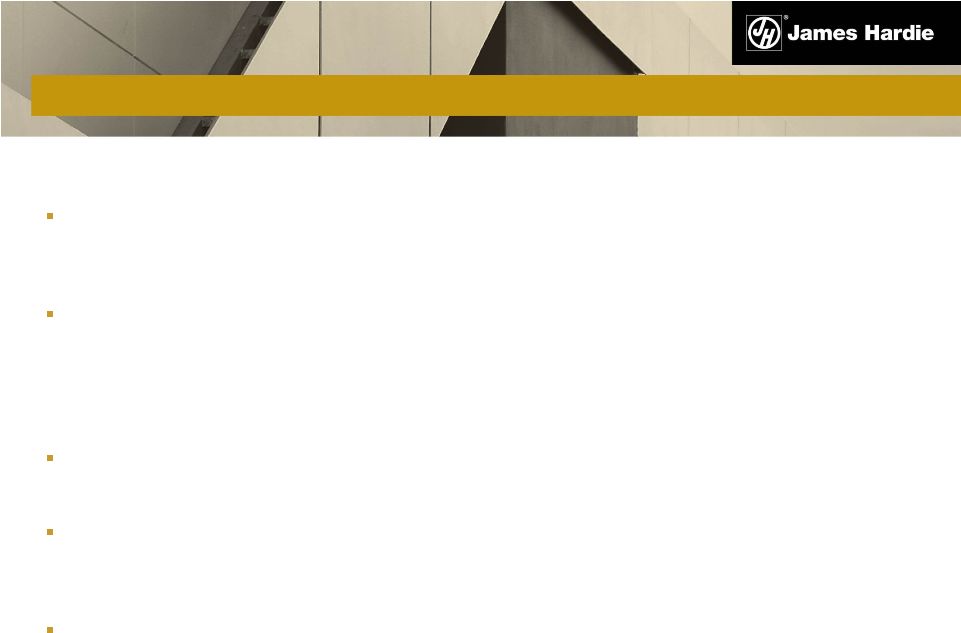 OVERVIEW
Highlights
Strong net operating cash flow and the favourable ATO decision has enabled a
further reduction
in
net
debt
from
US$40.4
million
at
31
March
2011
to
a
net
cash
position
of
US$265.4 million at 31 March 2012
10
February
2012
decision
of
the
High
Court
of
Australia
to
deny
ATO’s
application
for
leave to appeal finalized the matter in RCI’s favour. On 27 February 2012, the
company received a refund of US$265.8 million. On 7 March 2012, the
company received an additional US$130.5 million for interest income on the
amounts taken to have been overpaid
During the 4
th
quarter the company recognized a US$485.2 million benefit within income
tax expense with regard to the ATO matter
As
of
31
March
2012,
the
company
had
repurchased
3.4
million
shares
at
an
aggregate
cost of A$19.1 million (US$19.0 million) and an average price paid per security of
A$5.59 (US$5.55). The company did not purchase any shares during the
fourth quarter Dividend of US38.0 cents per security to be paid on 23 July
2012 18
1
After funding US$138.7 million early payment to AICF
1 |
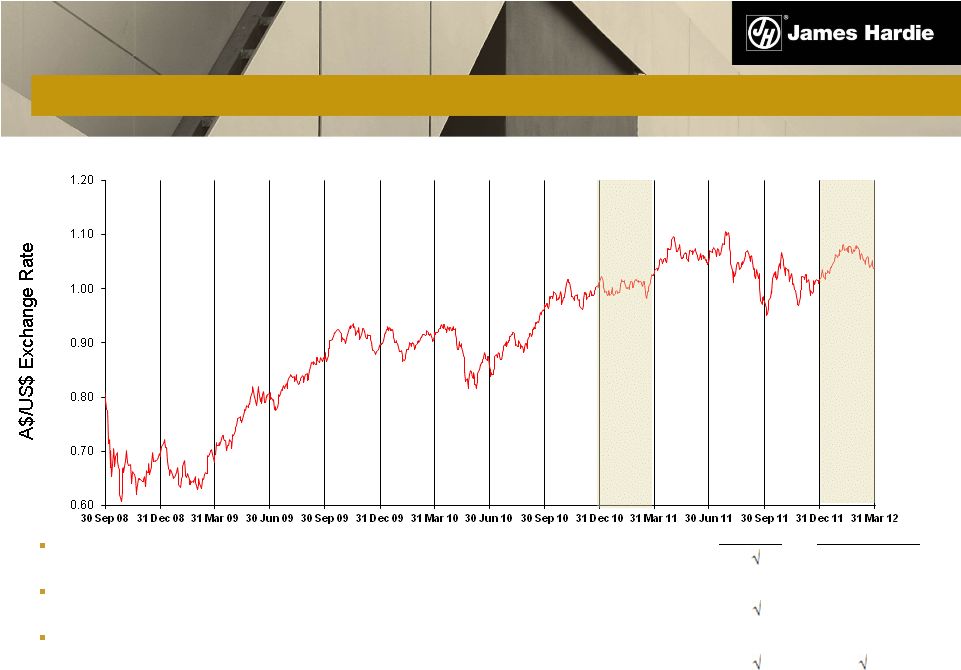 Favourable
impact
from
translation
of
Asia
Pacific
results
–
Q4
FY12
vs
Q4 FY11
Unfavourable
impact
on
corporate
costs
incurred
in
Australian
dollars
–
Q4
FY12 vs Q4 FY11
Unfavourable
impact
from
translation
of
asbestos
liability
balance
–
31
March
2012 vs 31 March 2011
19
Earnings
Balance Sheet
N/A
N/A
CONSEQUENCES OF CHANGES –
A$ VERSUS US$ |
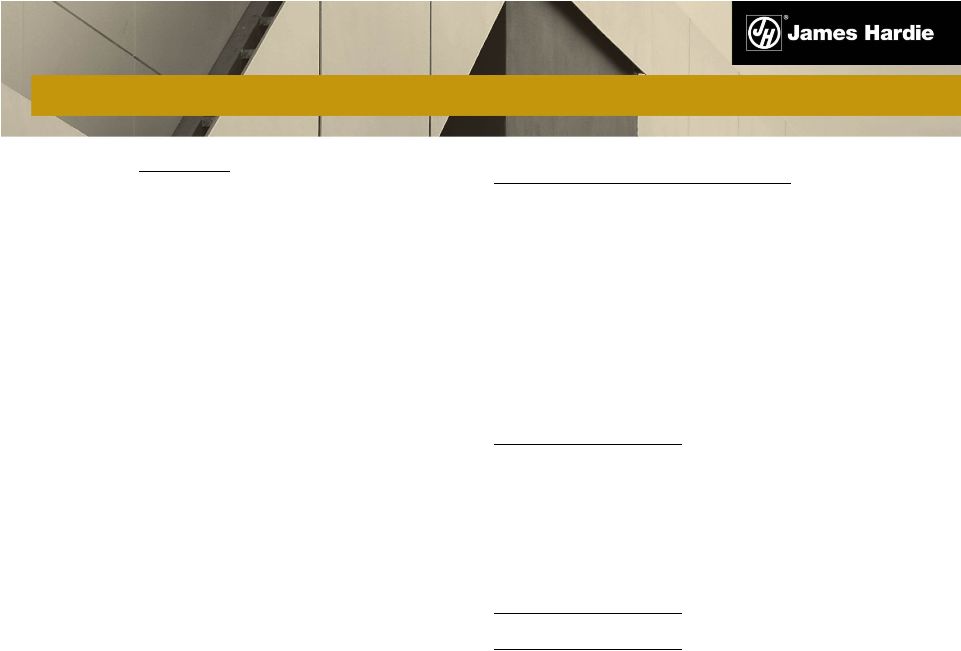 20
1
4
quarter
2012
includes
US$485.2
million
income
tax
benefit
as
a
result
of
RCI’s
successful
appeal
of
the
ATO’s
1999
disputed
amended
assessment,
quarter
2011
includes
a
charge
of
US$32.6
million
arising
from
the
company’s
corporate
structure
simplification
RESULTS –
Q4
US$ Millions
Q4 '12
Q4 '11
% Change
Net sales
309.3
288.4
7
Gross profit
95.6
96.9
(1)
SG&A expenses
(48.9)
(43.0)
(14)
Research & development expenses
(8.8)
(8.4)
(5)
Impairment charge
(14.3)
-
-
Asbestos adjustments
(31.0)
5.3
-
EBIT
(7.4)
50.8
-
Net interest expense
(3.7)
(1.1)
-
Other income
3.5
0.9
-
Income tax benefit (expense)
488.3
(52.4)
-
Net operating profit (loss)
480.7
(1.8)
-
th
th
1
4 |
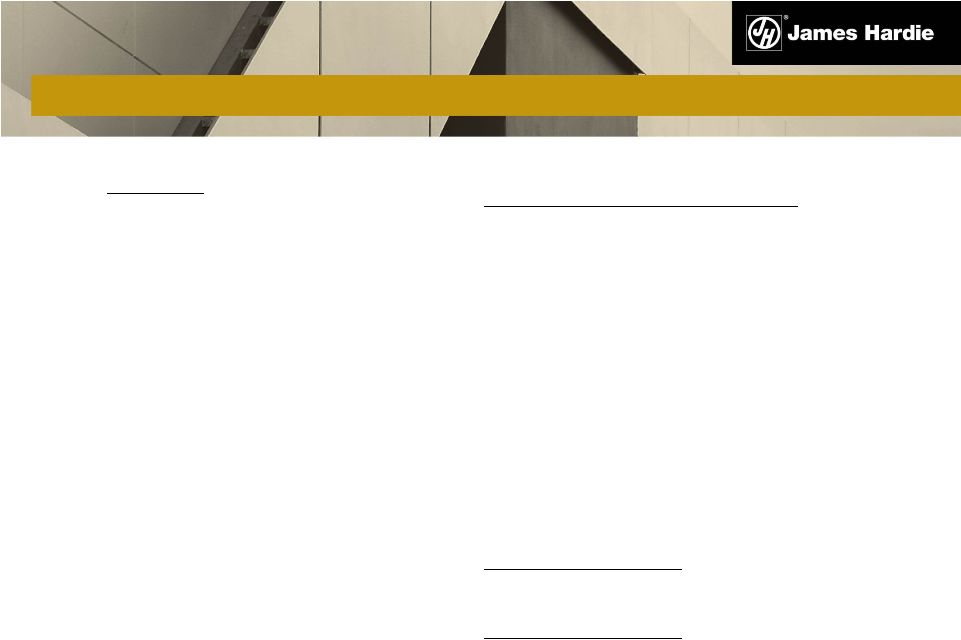 RESULTS
– Q4 (CONTINUED)
21
21
1
Includes AICF SG&A expenses and interest income
2
4 quarter 2012 includes US$485.2 million income tax benefit as
a result of RCI’s successful appeal of the ATO’s 1999 disputed amended
assessment, 4 quarter 2011 includes a charge of US$32.6 million
arising from the company’s corporate structure simplification th
th
US$ Millions
Q4 '12
Q4 '11
% Change
Net operating profit (loss)
480.7
(1.8)
-
Asbestos:
Asbestos adjustments
31.0
(5.3)
-
Other asbestos
(0.6)
(1.4)
57
Tax (benefit) expense related to asbestos
adjustments
(2.6)
6.3
-
ASIC related expenses
0.1
0.7
(86)
Asset impairments (net of tax)
9.3
-
-
Tax adjustments
(485.8)
34.8
-
Net operating profit excluding asbestos, ASIC
expenses, impairment charges and tax
adjustments
32.1
33.3
(4)
1
2 |
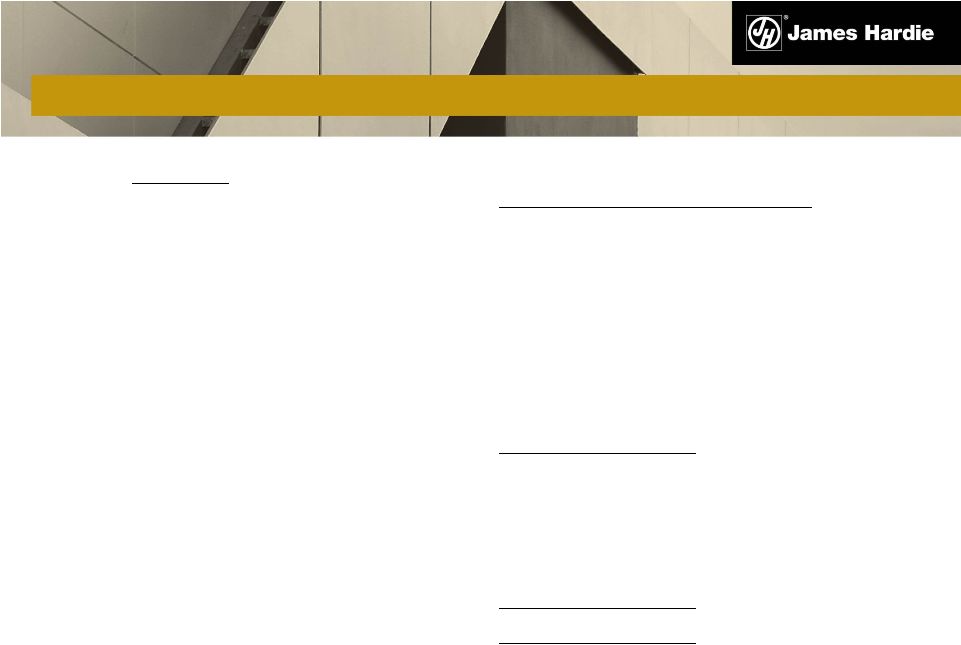 22
1
Fiscal year 2012 includes US$485.2 million income tax benefit as a result of
RCI’s successful appeal of the ATO’s 1999 disputed amended assessment.
Fiscal year 2011 includes a charge of US$345.2 million resulting from the dismissal
by the Federal Court of Australia of RCI’s appeal of the ATO’s disputed
1999 amended assessment and a charge of US$32.6 million arising from the
company’s corporate structure simplification US$ Millions
FY 2012
FY 2011
% Change
Net sales
1,237.5
1,167.0
6
Gross profit
407.0
391.9
4
SG&A expenses
(191.0)
(173.4)
(10)
Research & development expenses
(30.4)
(28.0)
(9)
Impairment charge
(14.3)
-
-
Asbestos adjustments
(15.8)
(85.8)
82
EBIT
155.5
104.7
49
Net interest expense
(7.4)
(4.4)
(68)
Other income (expense)
3.0
(3.7)
-
Income tax benefit (expense)
453.2
(443.6)
-
Net operating profit (loss)
604.3
(347.0)
-
1
RESULTS –
FULL YEAR |
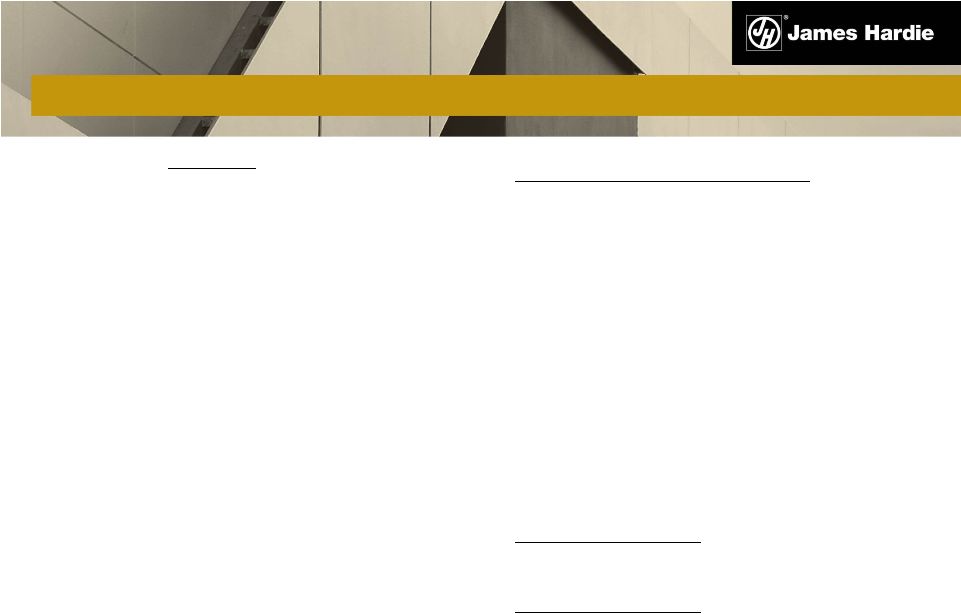 US$ Millions
FY 2012
FY 2011
% Change
Net operating profit (loss)
604.3
(347.0)
-
Asbestos:
Asbestos adjustments
15.8
85.8
(82)
Other asbestos
(0.5)
(2.1)
76
Tax (benefit) expense related to asbestos
adjustments
(2.7)
6.9
-
ASIC related expenses (recoveries)
1.1
(7.6)
-
Asset impairments (net of tax)
9.3
-
-
Tax adjustments
(486.9)
380.7
-
Net operating profit excluding asbestos, ASIC
expenses, asset impairments and tax
adjustments
140.4
116.7
20
1
2
RESULTS –
FULL YEAR (CONTINUED)
23
23
1
Fiscal year 2012 includes US$485.2 million income tax benefit as a result of
RCI’s successful appeal of the ATO’s 1999 disputed amended assessment.
Fiscal year 2011 includes
a charge of US$345.2 million resulting from the dismissal by the Federal Court
of Australia of RCI’s appeal of the ATO’s disputed 1999
amended assessment. and a charge of US$32.6 million arising from the company’s corporate structure simplification |
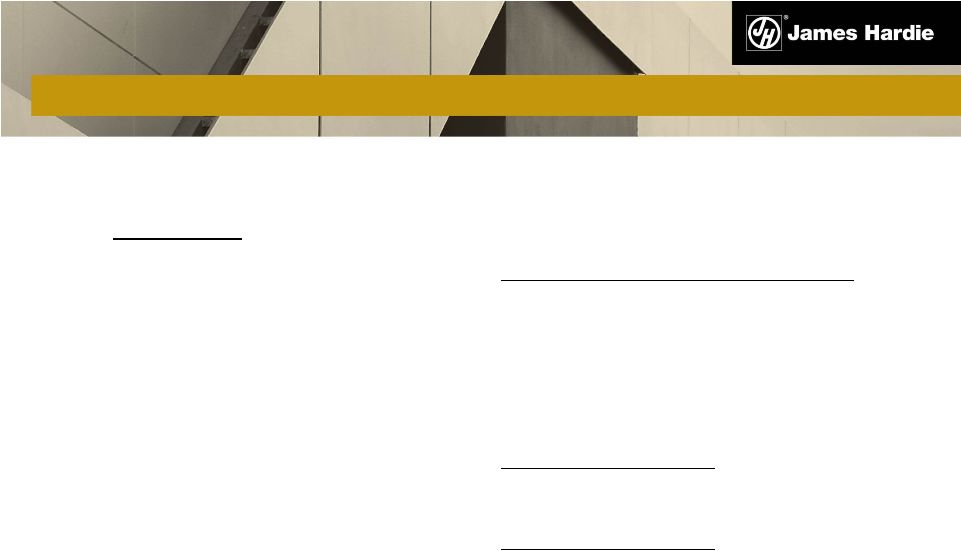 24
SEGMENT NET SALES –
Q4
US$ Millions
Q4 '12
Q4 '11
% Change
USA and Europe Fibre Cement
220.7
197.7
12
Asia Pacific Fibre Cement
88.6
90.7
(2)
Total
309.3
288.4
7 |
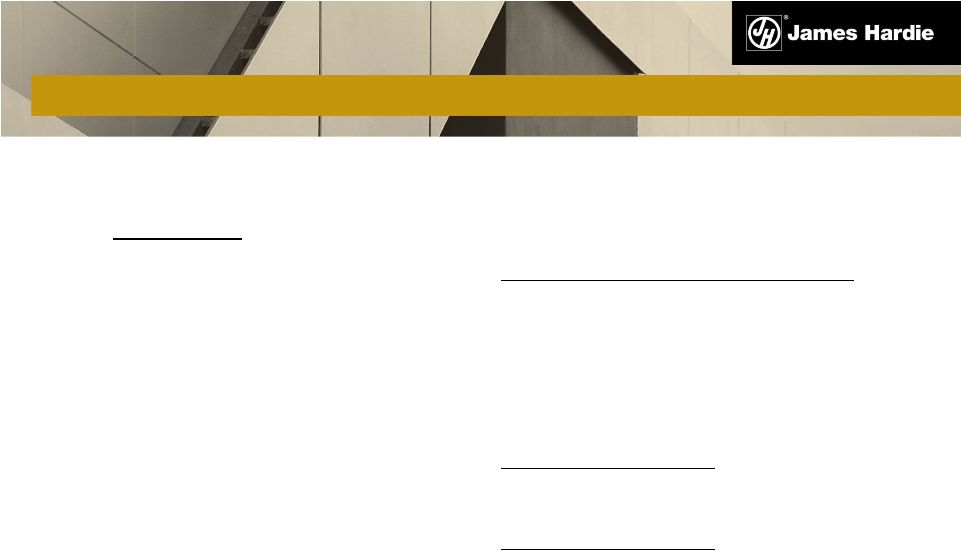 25
SEGMENT NET SALES –
FULL YEAR
US$ Millions
FY 2012
FY 2011
% Change
USA and Europe Fibre Cement
862.0
814.0
6
Asia Pacific Fibre Cement
375.5
353.0
6
Total
1,237.5
1,167.0
6 |
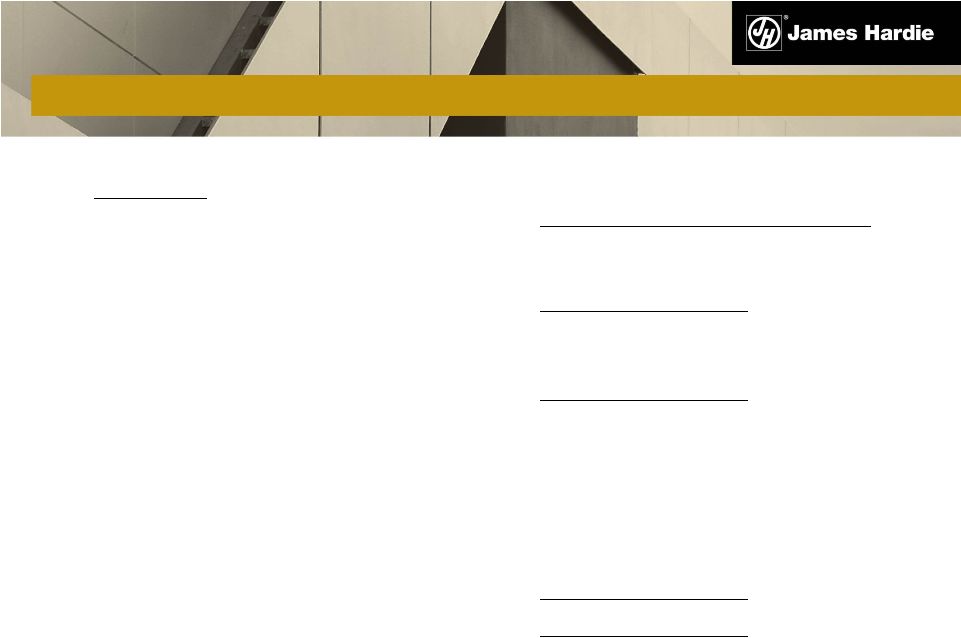 26
SEGMENT EBIT–
Q4
US$ Millions
Q4 ’12
Q4 ’11
% Change
USA and Europe Fibre Cement
36.4
38.5
(5)
Asia Pacific Fibre Cement
14.3
19.4
(26)
Research & development
(5.5)
(6.1)
10
Total segment EBIT excluding asset impairments
45.2
51.8
(13)
General corporate excluding asbestos and ASIC
expenses
(6.7)
(5.0)
(34)
Total EBIT excluding asbestos, ASIC
expenses and asset impairments
38.5
46.8
(18)
Asbestos adjustments
(31.0)
5.3
-
AICF SG&A expenses
(0.5)
(0.5)
-
ASIC expenses
(0.1)
(0.8)
88
Asset impairments
(14.3)
-
-
Total EBIT
(7.4)
50.8
-
1
1
Research and development expenses include costs associated with research projects that are designed
to benefit all business
units. These costs are recorded in the Research and Development segment rather than attributed
to individual business units. |
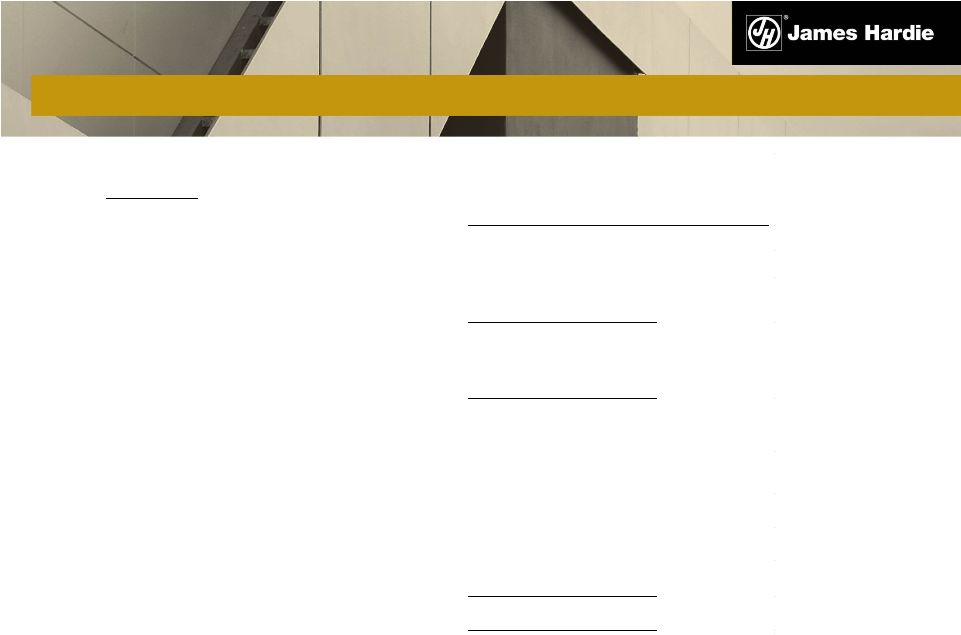 1
Research and development expenses include costs associated with research projects
that are designed to benefit all business units. These costs are recorded in
the Research and Development segment rather than attributed to individual business units.
27
SEGMENT EBIT–
FULL YEAR
US$ Millions
FY 2012
FY 2011
% Change
USA and Europe Fibre Cement
162.7
160.3
1
Asia Pacific Fibre Cement
80.3
79.4
1
Research
&
development
(20.7)
(20.1)
(3)
Total segment EBIT excluding asset impairments
222.3
219.6
1
General corporate excluding asbestos and ASIC
expenses
(32.8)
(35.6)
8
Total EBIT excluding asbestos, ASIC
expenses and asset impairments
189.5
184.0
3
Asbestos adjustments
(15.8)
(85.8)
82
AICF SG&A expenses
(2.8)
(2.2)
(27)
ASIC (expenses) recoveries
(1.1)
8.7
-
Asset impairments
(14.3)
-
-
Total EBIT
155.5
104.7
49
1 |
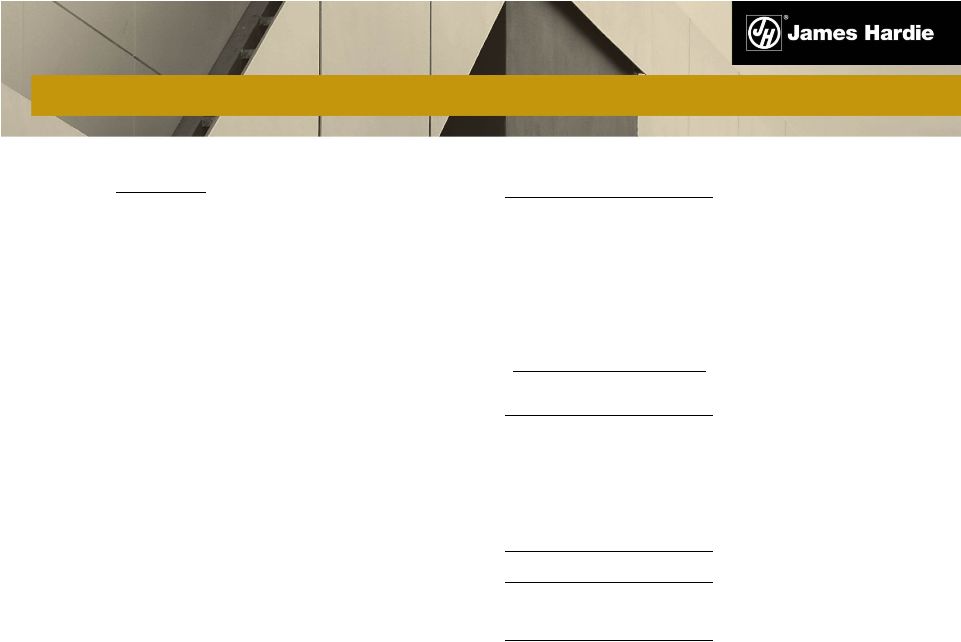 28
US$ Millions
Operating (loss) profit before income taxes
(7.6)
50.6
Asbestos:
Asbestos adjustments
31.0
(5.3)
Other asbestos
(0.6)
(1.4)
Asset impairments
14.3
-
Operating profit before income taxes excluding asbestos
and asset impairments
37.1
43.9
Income tax benefit (expense)
Asbestos:
Tax (benefit) expense related to asbestos adjustments
(2.6)
6.3
Tax benefit related to asset impairments
(5.0)
-
Tax adjustments
(485.8)
34.8
Income tax expense excluding tax adjustments
(5.1)
(11.3)
Effective tax rate excluding asbestos, asset impairments
and tax adjustments
13.7%
25.7%
Q4 '12
Q4 '11
488.3
(52.4)
1
2
1
Includes AICF SG&A expenses and interest income
2
4 quarter 2012 includes US$485.2 million income tax benefit as
a result of RCI’s successful appeal of the ATO’s 1999 disputed amended
assessment, 4
quarter 2011 includes a charge of US$32.6 million arising from the company’s
corporate structure simplification INCOME TAX EXPENSE –
Q4
th
th |
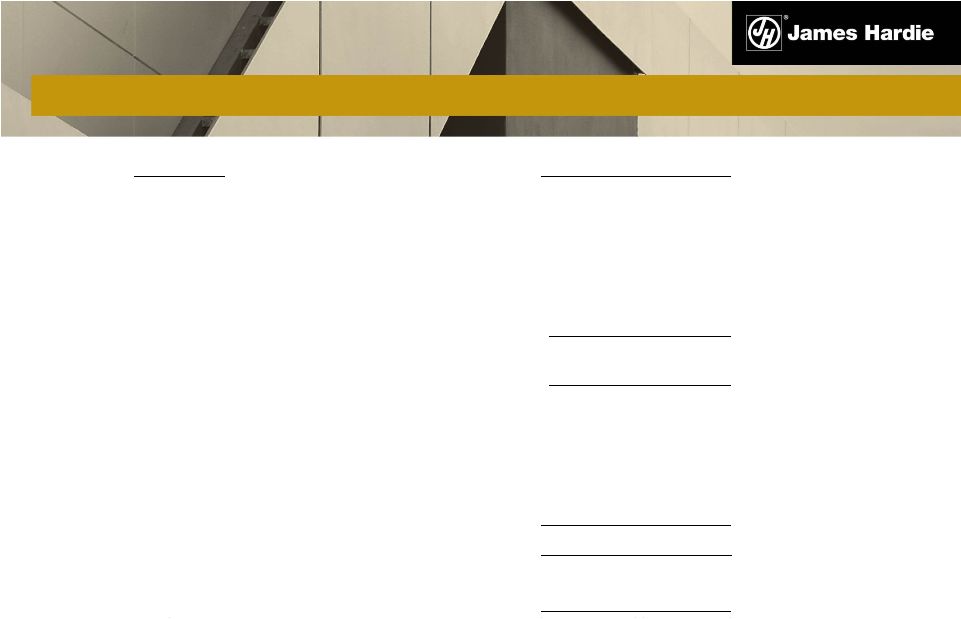 29
1
Includes AICF SG&A expenses and interest income
2
Fiscal
year
2012
includes
US$485.2
million
income
tax
benefit
as
a
result
of
RCI’s
successful
appeal
of
the
ATO’s
1999
disputed
amended
assessment. Fiscal year 2011 includes a charge of US$345.2 million resulting from
the dismissal by the Federal Court of Australia of RCI’s appeal of the
ATO’s disputed 1999 amended assessment and a charge of US$32.6 million
arising from the company’s corporate structure simplification INCOME TAX
EXPENSE – FULL YEAR
US$ Millions
FY 2012
FY 2011
Operating profit before income taxes
151.1
96.6
Asbestos:
Asbestos adjustments
15.8
85.8
Other
asbestos
1
(0.5)
(2.1)
Asset impairments
14.3
-
Operating profit before income taxes excluding asbestos
and asset impairments
180.7
180.3
Income tax benefit (expense)
453.2
(443.6)
Asbestos:
Tax (benefit) expense related to asbestos adjustments
(2.7)
6.9
Tax benefit related to asset impairments
(5.0)
-
Tax adjustments
2
(486.9)
380.7
Income tax expense excluding tax adjustments
(41.4)
(56.0)
Effective tax rate excluding asbestos, asset impairments
and tax adjustments
22.9%
31.1% |
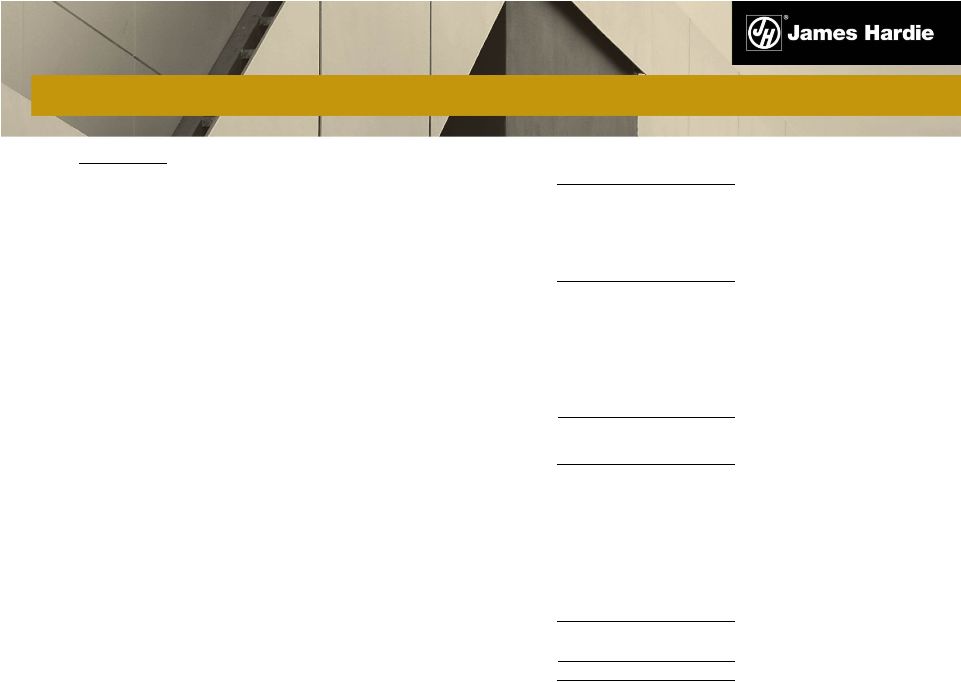 30
CASHFLOW
1
US$ Millions
FY 2012
FY 2011
EBIT
155.5
104.7
Non-cash items:
Asbestos adjustments
15.8
85.8
Other non-cash items
73.0
51.0
Net working capital movements
82.1
(21.4)
Cash Generated By Trading Activities
326.4
220.1
Tax refunds (payments), net
238.1
(38.7)
Change in other non-trading assets and liabilities
(127.1)
40.7
Change in asbestos-related assets & liabilities
(140.5)
(2.1)
Payment to the AICF
(51.5)
(63.7)
Impairment charge
14.3
-
Interest paid (net)
(11.2)
(9.1)
Net Operating Cash Flow Before Anticipated AICF Contribution
248.5
147.2
Restricted Cash - for contribution to the AICF April 2012
138.7
-
Net Operating Cash Flow
387.2
147.2
Purchases of property, plant & equipment
(35.8)
(50.3)
Proceeds from sale of property, plant & equipment
0.3
0.7
Deposit on acquisition
(14.4)
-
Common stock repurchased and cancelled
(19.0)
-
Dividends paid
(17.4)
-
Equity issued
11.0
5.3
Effect of exchange rate on cash
(6.1)
(8.5)
Movement In Net Cash (Debt)
305.8
94.4
Beginning Net Cash (Debt)
(40.4)
(134.8)
Ending Net Cash (Debt)
265.4
(40.4)
1
Comparisons are of the full year of the current fiscal year versus the full year of
the prior fiscal year |
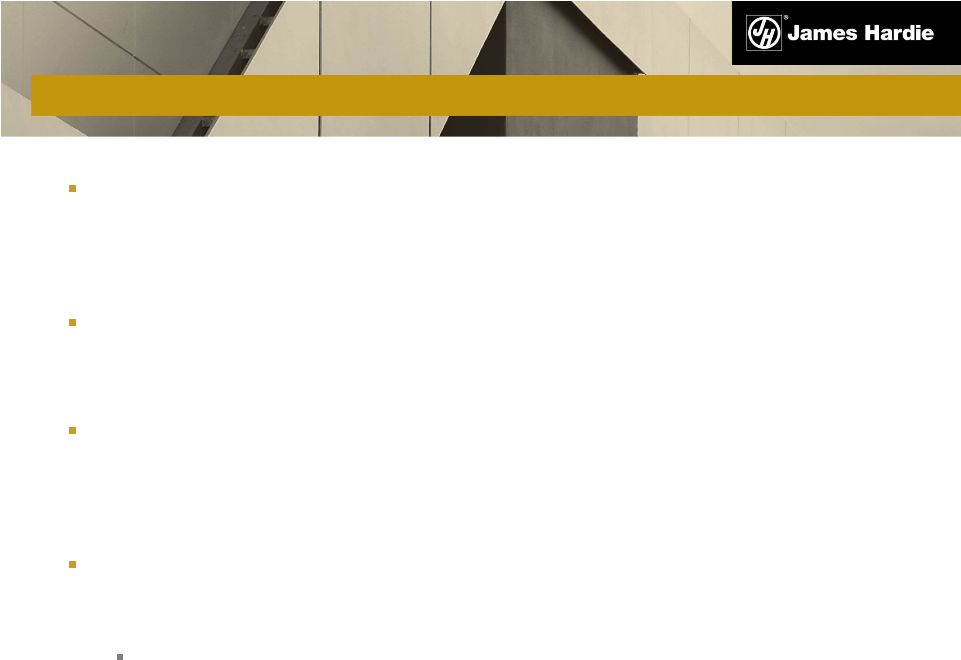 DIVIDEND
The company announced today an ordinary dividend of US38.0 cents
per
security
The full year dividend is US42.0 cents per security
The full year dividend is at the top end of the dividend payout ratio of 20% to
30% announced by the company in May 2011
The company intends to make further distributions to shareholders in the near
term and to improve capital efficiency through a more appropriately
leveraged balance sheet
This may be achieved, in part, with an increase in the dividend payout ratio
31 |
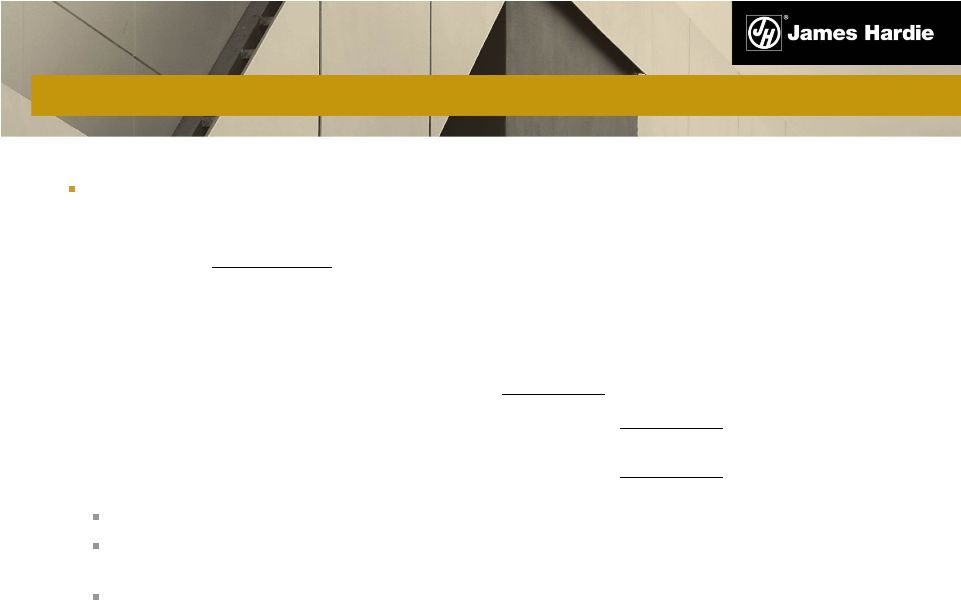 Net cash of US$265.4 million compared to net debt of US$40.4 million at 31 March
2011 Weighted average remaining term of total facilities was 0.9 years at 31
March 2012, down from 1.9 years at 31 March 2011
James Hardie remains well within its financial debt covenants
32
At 31 March 2012
DEBT
US$ Millions
Total facilities
280.0
Gross debt
-
Cash
265.4
Net debt (cash)
(265.4)
Unutilised facilities and cash
545.4 |
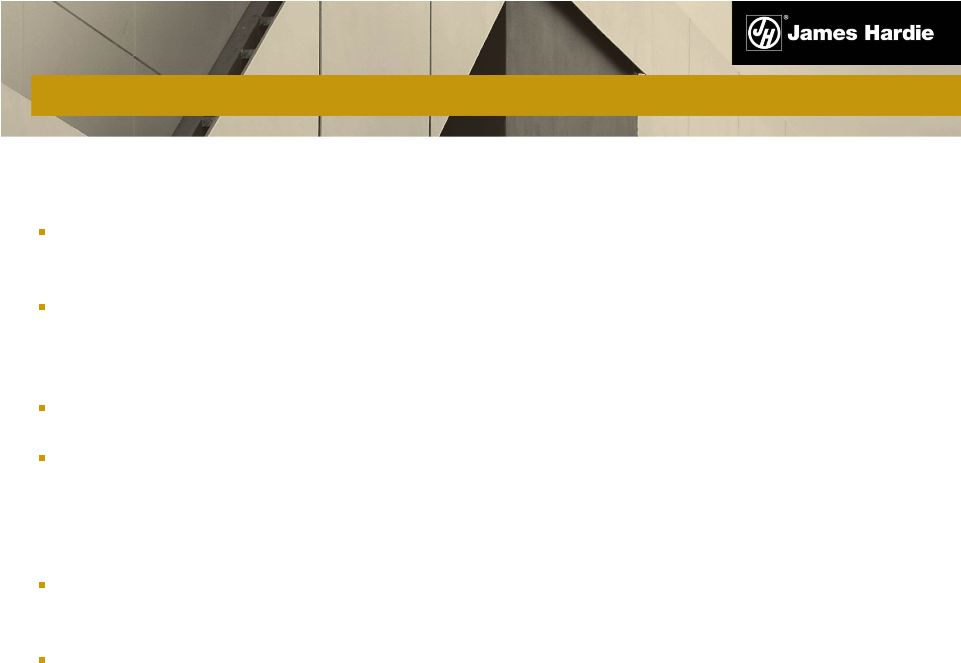 33
LEGACY ISSUES UPDATE
On 22 August 2011, the Full Federal Court upheld RCI’s appeal, ordered that
RCI’s objection be allowed in full and awarded RCI costs
The ATO filed an application for special leave to appeal the Full Federal
Court’s decision to the
High
Court
of
Australia.
On
10
February
2012,
the
High
Court
dismissed
the
ATO’s
application, thus finalising the matter in RCI’s favour
The ATO paid a total refund of US$396.3 million (A$369.8 million) in the fourth
quarter. The fourth quarter and full year results reflect a benefit of
US$485.2 million (A$452.9 million), which represents the total amount
refunded by the ATO and the reversal of the provision for the unpaid portion
of the amended assessment, partially offset by taxes payable on general
interest charges previously deducted and interest on overpayment of tax The
company has commenced recovery of a portion of the legal costs incurred in litigating
the amended assessment
On 2 April 2012, the company made an early contribution of US$138.7 million to the
AICF which represents 35% of the cash received from the ATO in the fourth
quarter ATO –
RCI successful in its appeal of the 1999 disputed amended tax assessment
|
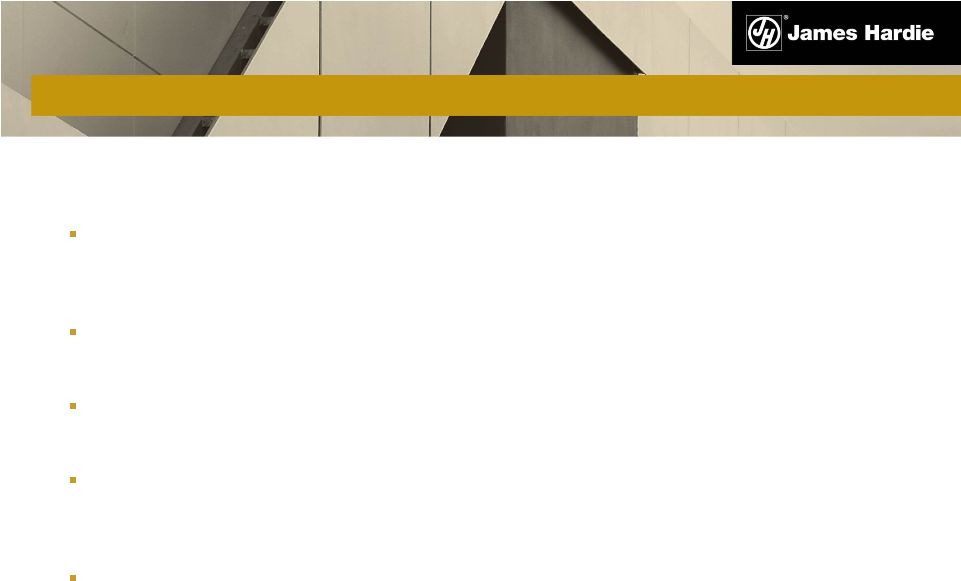 34
ASIC Proceedings
The High Court of Australia delivered its judgment in the appeals and cross
appeals against the December 2010 decision of the New South Wales Court of
Appeal on 3 May 2012
James Hardie did not appeal the NSW Court of Appeal’s decision, so it was not
party to the High Court proceedings
The High Court upheld ASIC’s appeal and dismissed a former officer’s
appeal against the court of appeal’s decision
The High Court remitted the matter back to the NSW Court of Appeal for further
consideration of claims to be excused from liability, penalty and
disqualification and on certain questions concerning costs
The
High
Court’s
decision
will
have
some
cost
implications
for
James
Hardie
but
the
company will not be able to assess those until the Court of Appeal has delivered
its judgment on the outstanding issues
LEGACY ISSUES UPDATE (CONTINUED) |
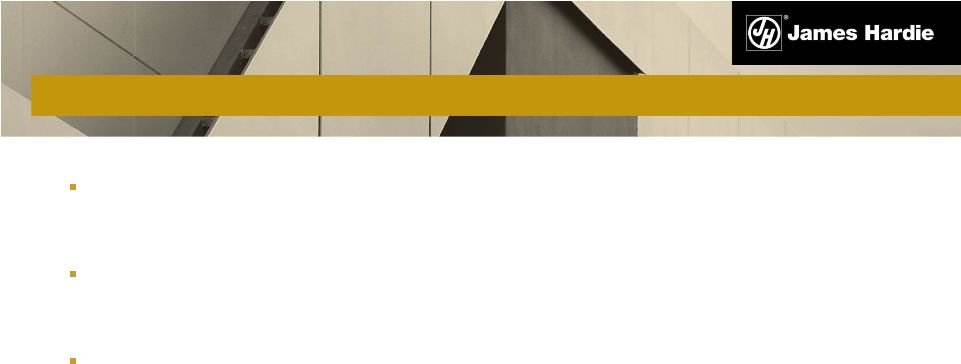 35
Updated actuarial report completed as at 31 March 2012
Discounted central estimate increased to A$1.580 billion from A$1.478
billion As per AFFA, a contribution of approximately US$184.1 million would
have been due to AICF in July 2012. However, an early contribution of
US$138.7 million was made by James Hardie to AICF on 2 April 2012, and the
remaining estimated US$45.4 million payment will be paid in July
2012. UPDATED ACTUARIAL ESTIMATE |
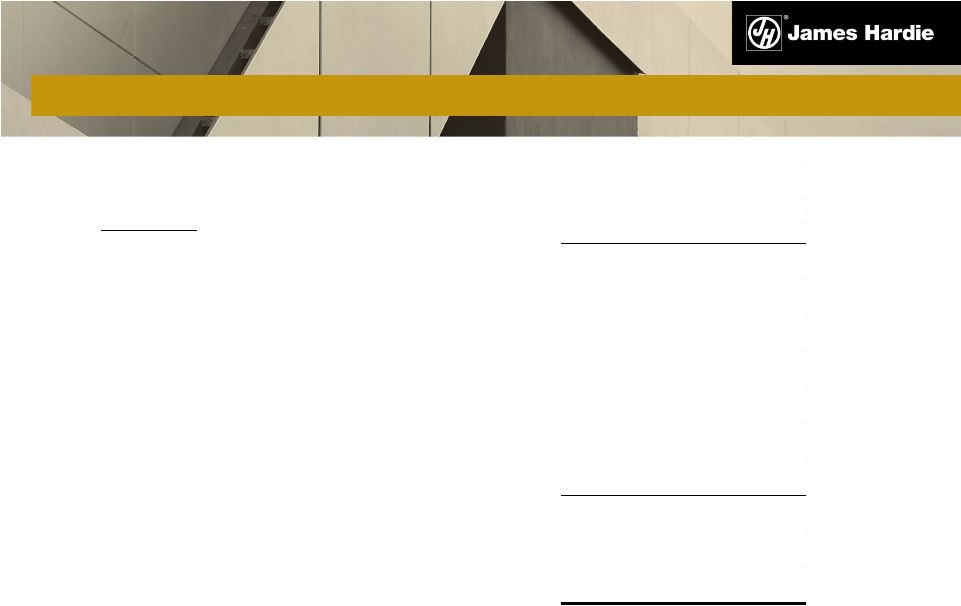 36
ASBESTOS COMPENSATION FUNDING ARRANGEMENTS
31-Mar-12
31-Mar-11
1,580.1
1,477.6
(267.0)
(113.3)
44.3
55.2
25.9
27.8
(32.7)
(1.2)
2.1
2.5
(446.5)
(464.9)
906.2
983.7
1.0402
1.0334
942.6
1,016.6
Net accounting liability under AFFA
A$ millions
(except where stated)
Central Estimate –
Discounted
Discounting and inflation allowance
Net post-tax unfunded liability in A$
Exchange rate A$ to US$
Net post-tax unfunded liability in US$ millions
Provision for claims handling costs of AICF
Other US GAAP adjustments
Net assets of AICF
Contributions for asbestos research and education
Effect of tax |
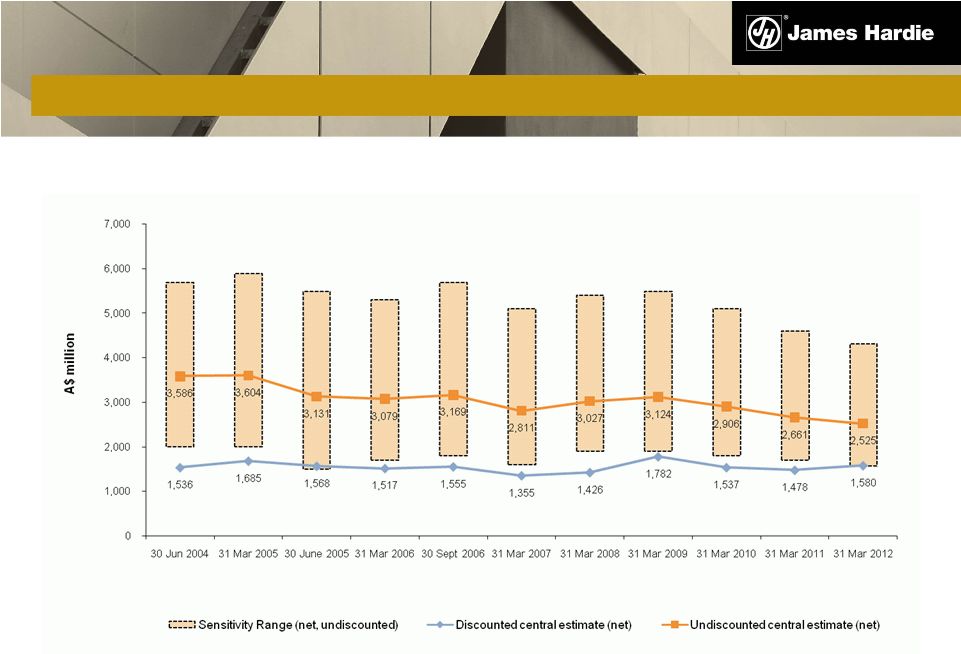 37
UPDATED ACTUARIAL ESTIMATE |
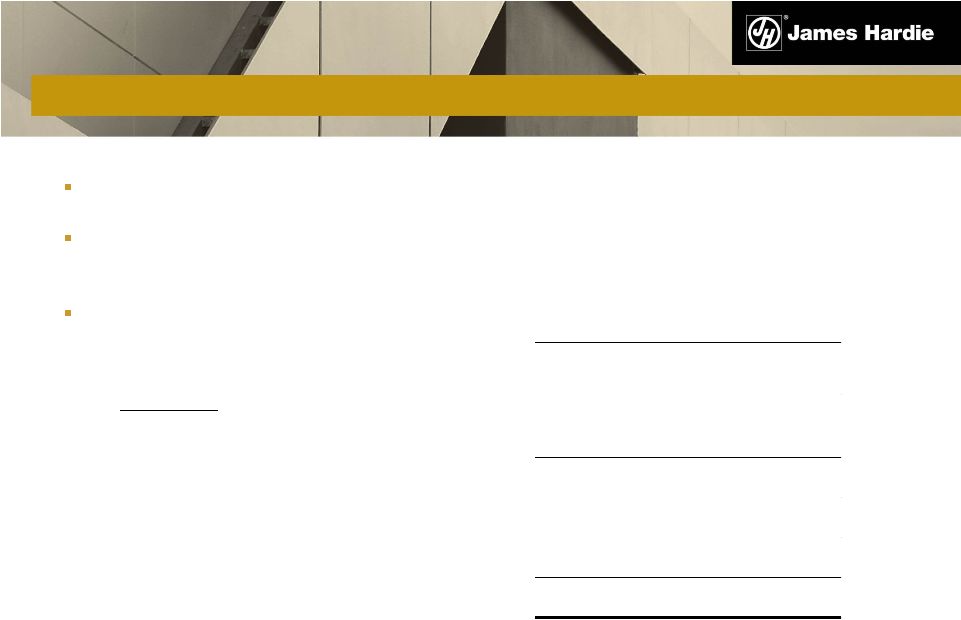 38
AICF holdings at 31 March 2012
A$62.5 million –
cash and short-term investments (A$59.9 million at 31 March
2011)
Net claims paid full year FY 2012:
Note:
On
17
February
2012
AICF
borrowed
A$29.7
million
under
the
secured
standby
loan
facility
with
the
NSW
Government.
On
3
April
2012
AICF repaid all amounts outstanding including accrued interest. JHISE is not a
guarantor of, party to, or security provider in respect of the facility. *FY
2012 Actuarial Estimate as at 31 March 2011 ASBESTOS COMPENSATION FUNDING
ARRANGEMENTS Claims Paid
88.2
95.6
91.3
Legal Costs
10.9
10.9
9.3
Insurance and cross claim recoveries
(23.8)
(12.5)
(24.2)
Total net claims costs
75.3
94.0
76.4
A$ Millions
AICF
Full
Year
2011
AICF
Full
Year
2012
KPMG
Actuarial
Estimate For
FY 2012* |
 *
Certain reclassifications have been reflected in the prior period shown above to
conform with current period presentation 1
Excludes
asbestos
adjustments,
AICF
SG&A
expenses,
AICF
interest
income,
gain
or
impairment
on
AICF
investments, tax benefits related to asbestos adjustments, ASIC
expenses/recoveries, tax adjustments and impairment charge 2
Excludes asbestos adjustments, AICF SG&A expenses, ASIC
expenses/recoveries and impairment charge 3
Excludes payments under the AFFA
39
*
KEY RATIOS
FY2012
FY 2011
FY 2010
EPS (Diluted)
32.1c
26.7c
30.5c
Dividend Paid per share
4.0c
N/A
N/A
Return on Shareholders’
Funds
10.9%
10.0%
13.3%
Return on Capital Employed
20.4%
19.7%
17.4%
EBIT/ Sales (EBIT margin)
15.3%
15.8%
18.6%
Gearing Ratio
-24.5%
3.2%
10.9%
Net Interest Expense Cover
23.8x
22.9x
28.6x
Net Interest Paid Cover
23.7x
21.8x
29.0x
Net Debt Payback
-
0.2yrs
0.7yrs
1, 3
1, 3
2, 3
2
1
2
2 |
 40
SUMMARY
1
Comparisons
are
of
the
4
th
quarter
and
full
year
of
the
current
fiscal
year
versus
the
4
th
quarter
and
full
year
of
the
prior
fiscal
year
Net operating profit, excluding asbestos, asset impairments, ASIC expenses and tax
adjustments for the 4th quarter and full year was US$32.1 million and
US$140.4 million, respectively
Full year results reflected:
Moderately improved US and slowing Asia Pacific operating environments
Higher sales volumes in US and Europe segment due to gains in market and
category share, offset by a reduction in average net sales price
and higher
organisational costs
Higher SG&A expenses for full year primarily due to US$10.3 million third
party recovery in prior year and higher employment and administrative
expenses in US and
Europe
segment
in
4
th
quarter
of
current
year
Appreciation
of
Asia
Pacific
business’
currencies
against
US
dollar
1 |
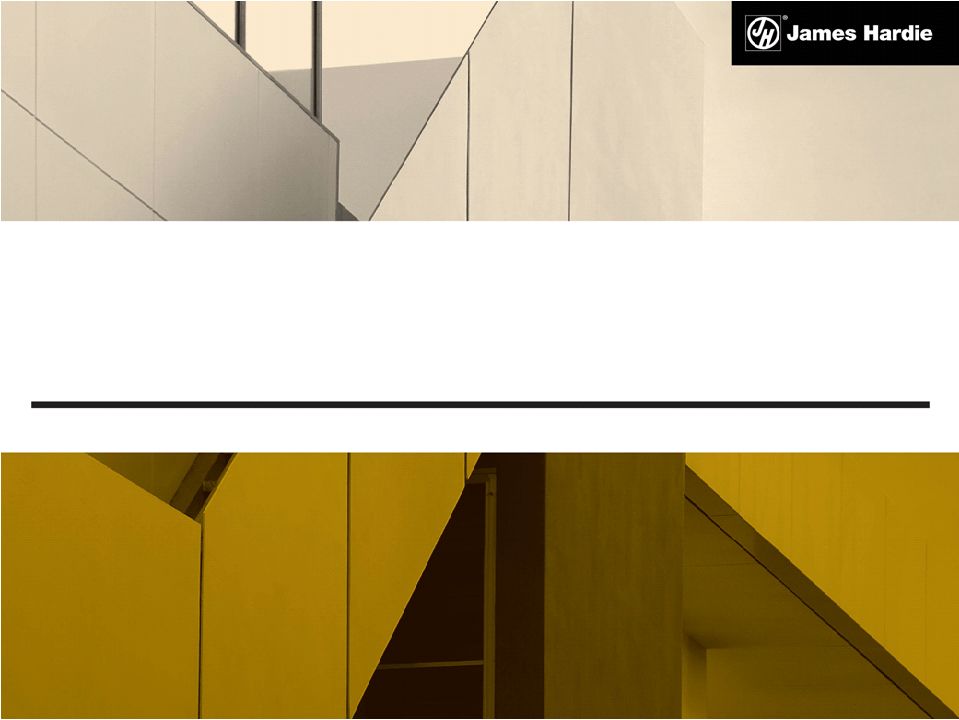 QUESTIONS |
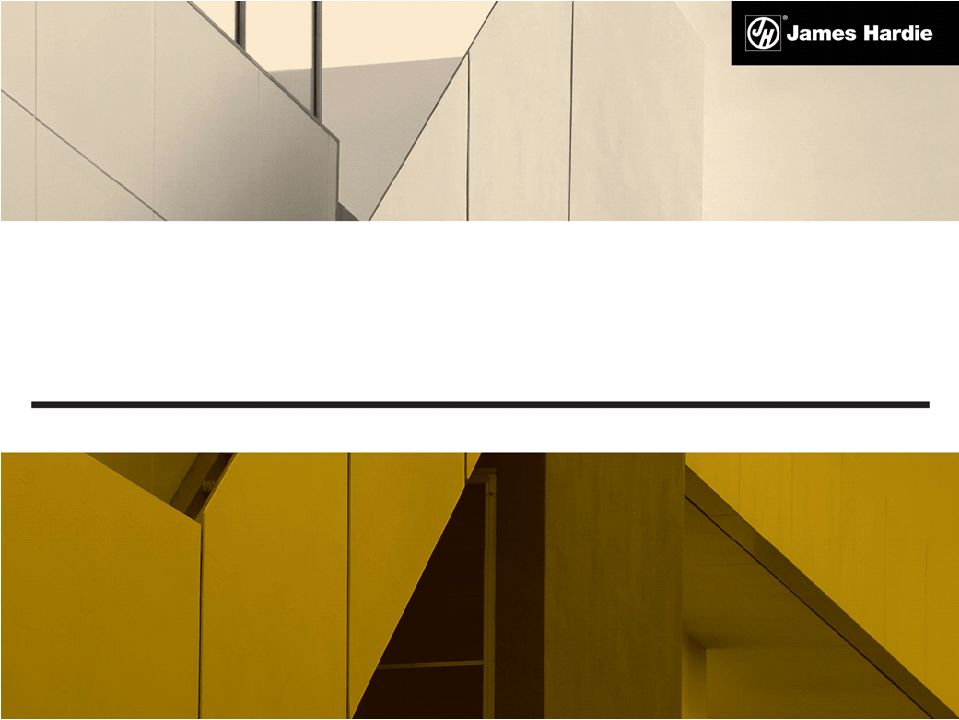 APPENDIX |
 Aggressively grow demand for our products in targeted market segments
Grow our overall market position while defending our share in existing
market segments
Offer products with superior value to that of our competitors
Introduce differentiated products to deliver a sustainable competitive
advantage
43
GLOBAL STRATEGY |
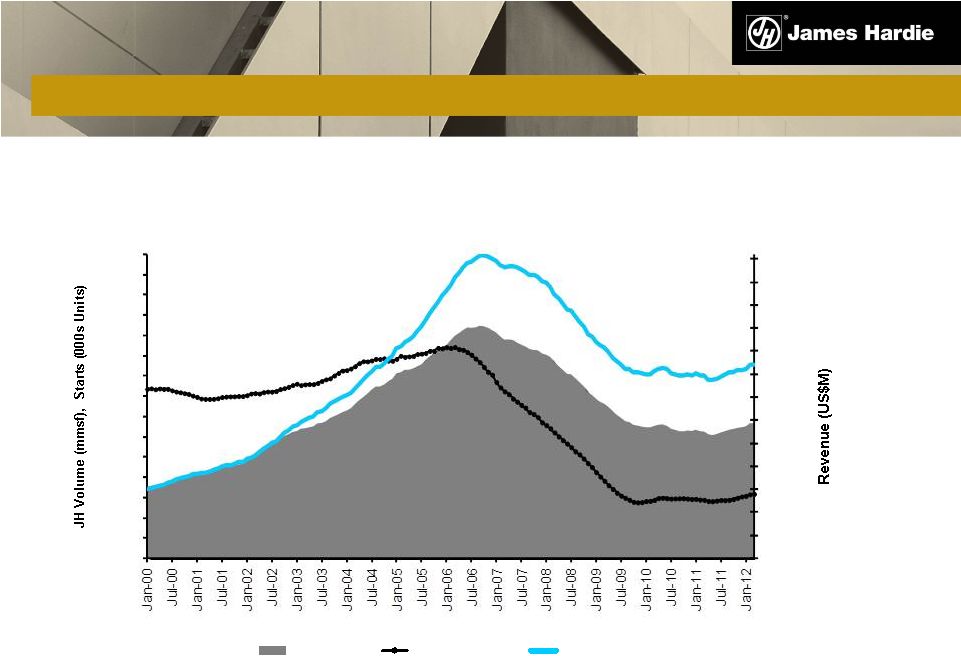 Rolling 12 month average of seasonally adjusted estimate of housing starts by US
Census Bureau 44
USA FIBRE CEMENT
$0
$100
$200
$300
$400
$500
$600
$700
$800
$900
$1,000
$1,100
$1,200
$1,300
0
200
400
600
800
1,000
1,200
1,400
1,600
1,800
2,000
2,200
2,400
2,600
2,800
3,000
Top Line Growth
JH Volume
Housing Starts
JH Revenue |
 GENERAL
CORPORATE COSTS – Q4
45
US$ Millions
% Change
Stock compensation expense
2.7
2.3
(17)
Other costs
4.0
2.7
(48)
General corporate costs excluding ASIC
expenses
6.7
5.0
(34)
ASIC related expenses
0.1
0.8
88
General corporate costs
6.8
5.8
(17)
Q4 '12
Q4 '11 |
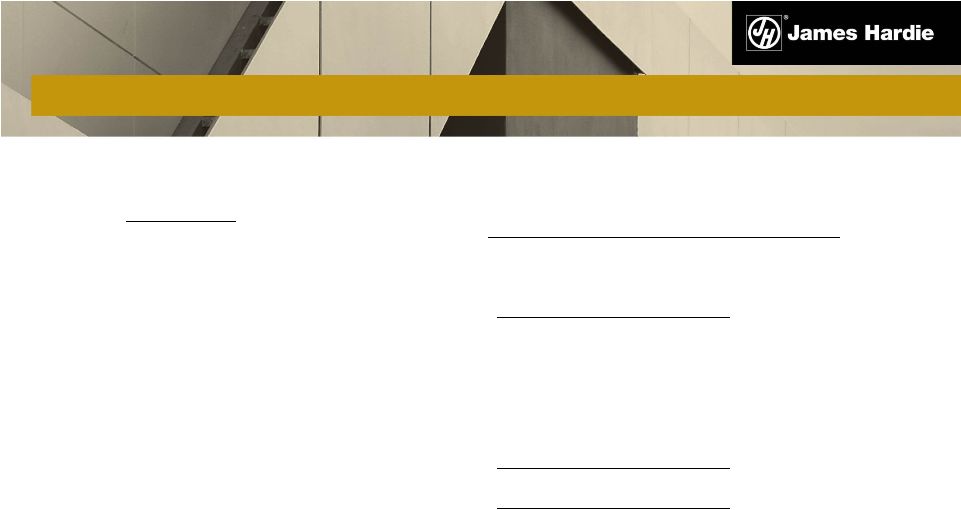 46
GENERAL CORPORATE COSTS –
FULL YEAR
US$ Millions
FY 2012
FY 2011
% Change
Stock compensation expense
11.1
11.3
2
Other costs
21.7
22.5
4
General corporate costs excluding ASIC
expenses and domicile change related
costs
32.8
33.8
3
ASIC related expenses (recoveries)
1.1
(8.7)
-
Domicile change related costs
-
1.8
-
General corporate costs
33.9
26.9
(26)
*FY2011 includes US$10.3 million recovery from third parties
|
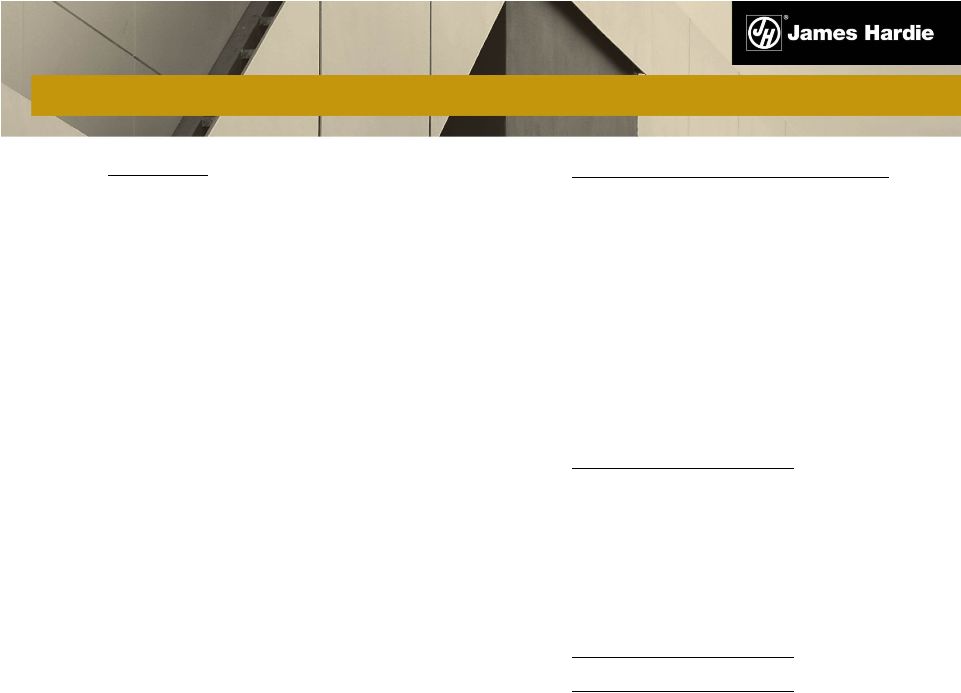 47
EBITDA –
Q4
US$ Millions
Q4 ’12
Q4 ’11
% Change
EBIT
USA and Europe Fibre Cement
36.4
38.5
(5)
Asia Pacific Fibre Cement
14.3
19.4
(26)
Research & development
(5.5)
(6.1)
10
General corporate excluding asbestos, ASIC expenses and
asset impairments
(6.7)
(5.0)
(34)
Depreciation and Amortisation
USA and Europe Fibre Cement
14.7
13.3
11
Asia Pacific Fibre Cement
2.7
2.7
-
Total EBITDA excluding asbestos, ASIC expenses and
asset impairments
55.9
62.8
(11)
Asbestos adjustments
(31.0)
5.3
-
AICF SG&A expenses
(0.5)
(0.5)
-
Asset impairments
(14.3)
-
ASIC expenses
(0.1)
(0.8)
-
Total EBITDA
10.0
66.8
(85) |
 48
EBITDA –
FULL YEAR
US$ Millions
FY 2012
FY 2011
% Change
EBIT
USA and Europe Fibre Cement
162.7
160.3
1
Asia Pacific Fibre Cement
80.3
79.4
1
Research & development
(20.7)
(20.1)
(3)
General corporate excluding asbestos, ASIC expenses and
asset impaiments
(32.8)
(35.6)
8
Depreciation and Amortisation
USA and Europe Fibre Cement
54.5
52.9
3
Asia Pacific Fibre Cement
10.7
10.0
7
Total EBITDA excluding asbestos, ASIC expenses and
asset impairments
254.7
246.9
3
Asbestos adjustments
(15.8)
(85.8)
82
AICF SG&A expenses
(2.8)
(2.2)
(27)
ASIC (expenses) recoveries
(1.1)
8.7
Asset impairments
(14.3)
-
-
Total EBITDA
220.7
167.6
32 |
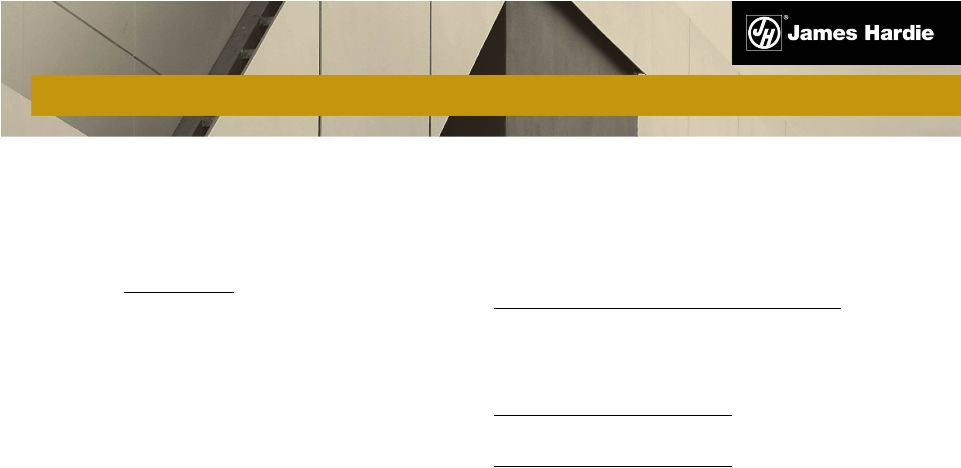 49
CAPITAL EXPENDITURE
US$ Millions
FY 2012
FY 2011
% Change
USA and Europe Fibre Cement
29.1
40.4
(28)
Asia Pacific Fibre Cement
6.7
9.9
(32)
Total
35.8
50.3
(29) |
 50
NET INTEREST EXPENSE
US$ Millions
Q4 ’12
Q4 ’11
FY 2012
FY 2011
Gross interest expense
(0.8)
(2.0)
(3.7)
(5.2)
Interest income
0.3
0.1
0.5
0.4
Realised loss on interest rate swaps
(4.3)
(1.1)
(7.5)
(3.9)
Net interest expense excluding AICF interest income
(4.8)
(3.0)
(10.7)
(8.7)
AICF interest income
1.1
1.9
3.3
4.3
Net interest expense
(3.7)
(1.1)
(7.4)
(4.4) |
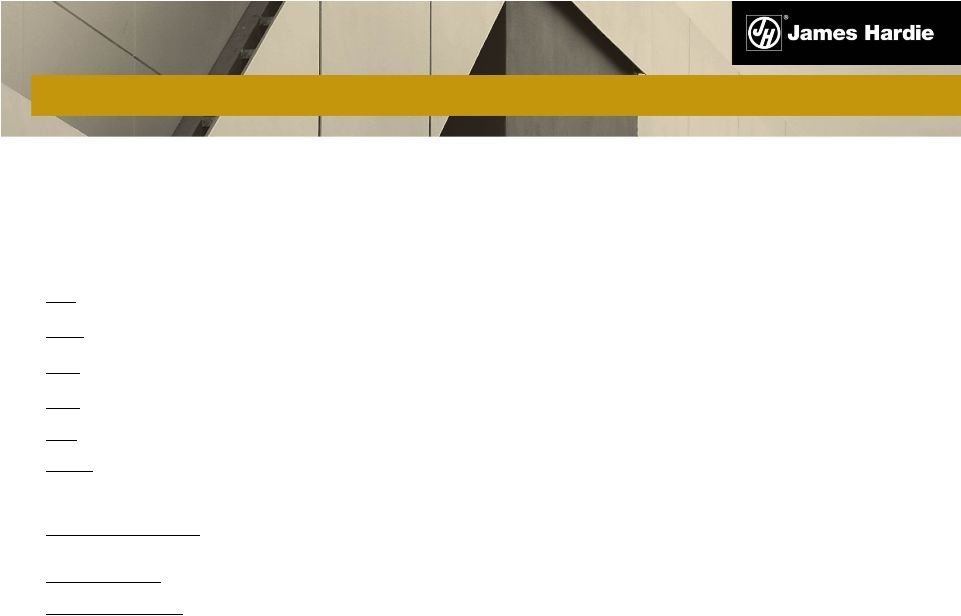 This Management Presentation forms part of a package of information about the
company’s results. It should be read in conjunction with the
other parts of this package, including the Management’s Analysis of Results, Media Release and Consolidated
Financial Statements.
Definitions
Non-financial Terms
ABS
–
Australian Bureau of Statistics.
AFFA
–
Amended and Restated Final Funding Agreement.
AICF
–
Asbestos Injuries Compensation Fund Ltd.
ASIC
–
Australian Securities and Investments Commission.
ATO
–
Australian Taxation Office.
NBSK –
Northern Bleached Soft Kraft; the company's benchmark grade of pulp.
Financial
Measures
–
US
GAAP
equivalents
EBIT and EBIT Margin
-
EBIT, as used in this document, is equivalent to the US GAAP measure of operating
income. EBIT margin is defined as EBIT as a percentage of net sales.
Operating profit
-
is equivalent to the US GAAP measure of income.
Net operating profit
-
is equivalent to the US GAAP measure of net income.
51
ENDNOTES |
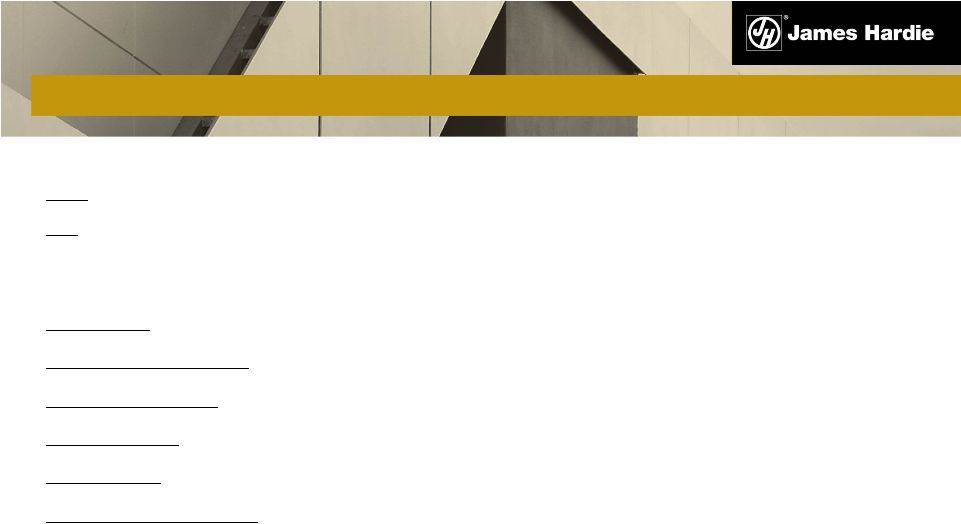 Sales Volumes
mmsf
–
million
square
feet,
where
a
square
foot
is
defined
as
a
standard
square
foot
of
5/16”
thickness.
msf
–
thousand
square
feet,
where
a
square
foot
is
defined
as
a
standard
square
foot
of
5/16”
thickness.
Financial Ratios
Gearing
Ratio
–
Net
debt
(cash)
divided
by
net
debt
(cash)
plus
shareholders’
equity.
Net interest expense cover
–
EBIT divided by net interest expense (excluding loan establishment fees).
Net
interest
paid
cover
–
EBIT
divided
by
cash
paid
during
the
period
for
interest,
net
of
amounts
capitalised.
Net debt payback
–
Net debt (cash) divided by cash flow from operations.
Net debt (cash)
–
Short-term and long-term debt less cash and cash equivalents.
Return on Capital employed
–
EBIT divided by gross capital employed.
52
ENDNOTES (CONTINUED) |
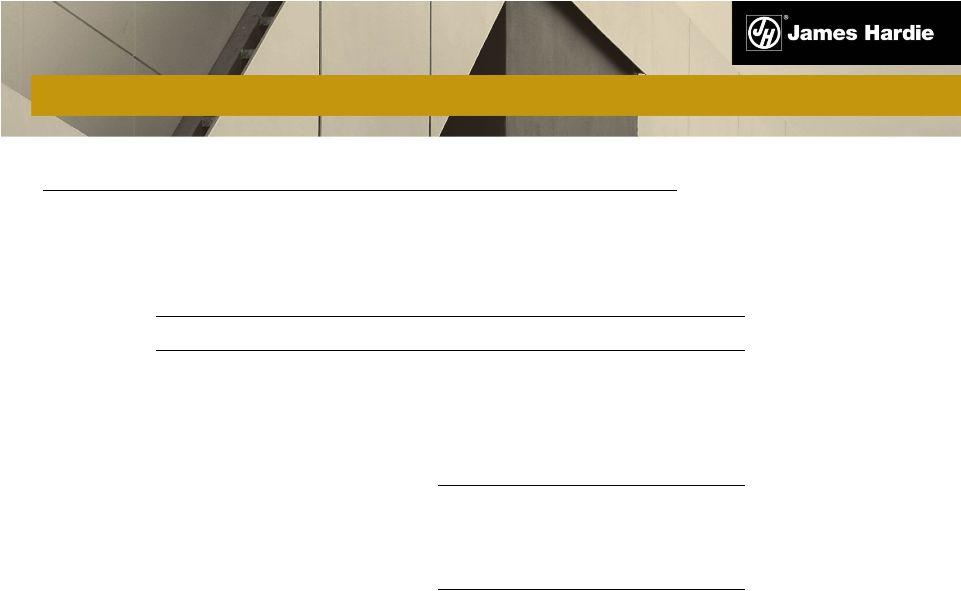 EBIT
and
EBIT
margin
excluding
asbestos,
asset
impairments
and
ASIC
expenses–
EBIT
and
EBIT
margin
excluding
asbestos, asset impairments and ASIC expenses are not measures of financial
performance under US GAAP and should not be considered to be more meaningful
than EBIT and EBIT margin. Management has included these financial measures to
provide investors with an alternative method for assessing its operating results in
a manner that is focussed on the performance of its ongoing operations and
provides useful information regarding its financial condition and results of
operations. Management uses these non-US GAAP measures for the same
purposes. 53
NON-US GAAP FINANCIAL MEASURES
Q4
Q4
US$ Millions
FY 2012
FY 2011
FY 2012
FY 2011
EBIT
$ (7.4)
$ 50.8
$ 155.5
$ 104.7
Asbestos:
Asbestos adjustments
31.0
(5.3)
15.8
85.8
AICF SG&A expenses
0.5
0.5
2.8
2.2
Asset impairments
14.3
-
14.3
-
ASIC related expenses (recoveries)
0.1
0.8
1.1
(8.7)
EBIT excluding asbestos, asset impairments and
ASIC expenses
38.5
46.8
189.5
184.0
Net sales
$ 309.3
$ 288.4
$ 1,237.5
$ 1,167.0
EBIT margin excluding asbestos, asset
impairments and ASIC expenses
12.4%
16.2%
15.3%
15.8% |
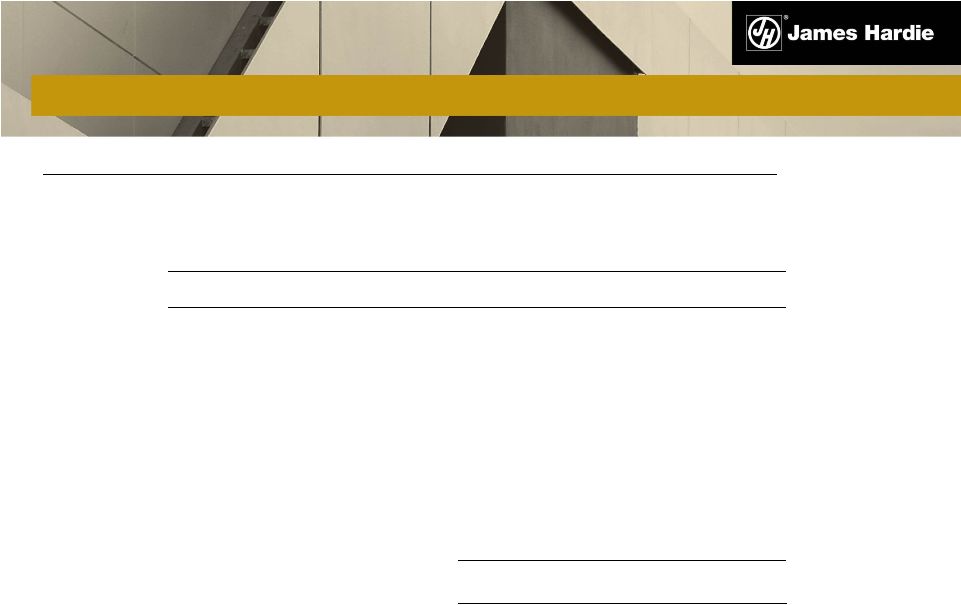 Net
operating profit excluding asbestos, asset impairments, ASIC expenses and tax
adjustments– Net operating profit
excluding asbestos, asset impairments, ASIC expenses and tax adjustments is not a
measure of financial performance under US GAAP and should not be considered
to be more meaningful than net income. Management has included this financial
measure to provide investors with an alternative method for assessing its operating
results in a manner that is focussed on the performance of its ongoing
operations. Management uses this non-US GAAP measure for the same purposes.
54
NON-US GAAP FINANCIAL MEASURES (CONTINUED)
1
The current full year included US$485.2 million income tax benefit as a result of RCI’s
successful appeal of the ATO’s 1999 disputed amended assessment, the prior year results
included a charge of US$345.2 million resulting from the dismissal by the Federal Court of Australia of RCI’s
appeal of the ATO’s disputed 1999 amended assessment. Readers are referred to Note 10 of the
condensed consolidated financial statements for further information.
Q4
Q4
US$ Millions
FY 2012
FY 2011
FY 2012
FY 2011
Net operating profit (loss)
$ 480.7
$ (1.8)
$ 604.3
$ (347.0)
Asbestos:
Asbestos adjustments
31.0
(5.3)
15.8
85.8
AICF SG&A expenses
0.5
0.5
2.8
2.2
AICF interest income
(1.1)
(1.9)
(3.3)
(4.3)
Tax (benefit) expense related to asbestos
adjustments
(2.6)
6.3
(2.7)
6.9
Asset impairments
14.3
-
14.3
-
ASIC related expenses (recoveries)
0.1
0.7
1.1
(7.6)
Tax benefit related to asset impairments
(5.0)
-
(5.0)
-
Tax adjustments
(485.8)
34.8
(486.9)
380.7
Net operating profit excluding asbestos, asset
impairments, ASIC expenses and tax adjustments
$ 32.1
$ 33.3
$ 140.4
$ 116.7
1 |
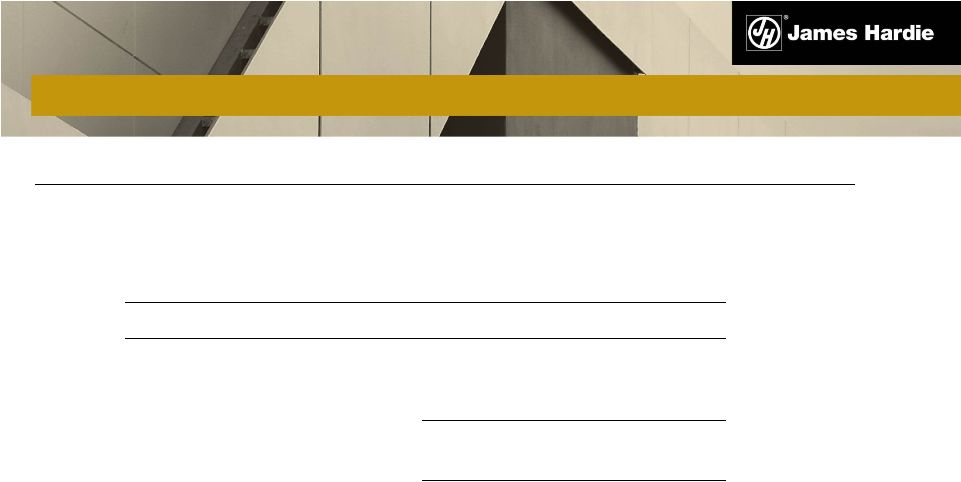 Non-US GAAP Financial Measures (continued)
Diluted
earnings
per
share
excluding
asbestos,
asset
impairments,
ASIC
expenses
and
tax
adjustments–
Diluted
earnings per share excluding asbestos, asset impairments, ASIC expenses and tax
adjustments is not a measure of financial performance under US GAAP and
should not be considered to be more meaningful than diluted earnings per share.
Management has included this financial measure to provide investors with an
alternative method for assessing its operating results in a manner that is
focussed on the performance of its ongoing operations. Management uses this non-US GAAP
measure for the same purposes.
55
NON-US GAAP FINANCIAL MEASURES (CONTINUED)
Q4
Q4
US$ Millions
FY 2012
FY 2011
FY 2012
FY 2011
Net operating profit excluding asbestos, asset
impairments, ASIC expenses and tax adjustments
$ 32.1
$ 33.3
$ 140.4
$ 116.7
Weighted average common shares outstanding -
Diluted (millions)
437.5
437.7
437.9
437.5
Diluted earnings per share excluding asbestos, asset
impairments, ASIC expenses and tax adjustments
(US cents)
7.3
7.6
32.1
26.7 |
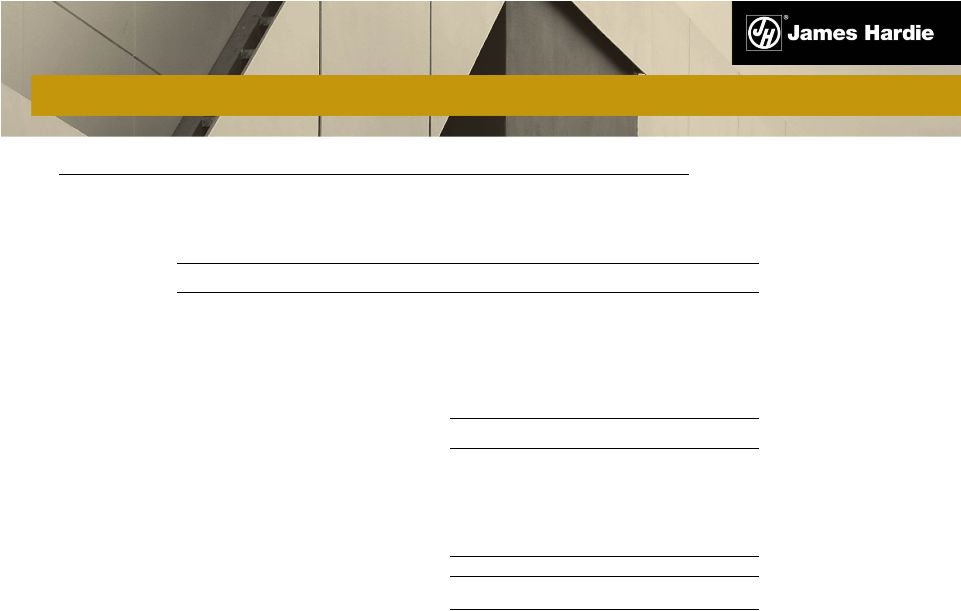 Effective
tax
rate
excluding
asbestos,
asset
impairments
and
tax
adjustments–
Effective
tax
rate
excluding
asbestos,
asset
impairments
and
tax
adjustments
is
not
a
measure
of
financial
performance
under
US
GAAP
and
should
not
be
considered
to
be
more
meaningful
than
effective
tax
rate.
Management
has
included
this
financial
measure
to
provide investors with an alternative method for assessing its operating results in
a manner that is focussed on the performance of its ongoing operations.
Management uses this non-US GAAP measure for the same purposes. 56
NON-US GAAP FINANCIAL MEASURES (CONTINUED)
¹
The current full year included US$485.2 million income tax benefit as a result of RCI’s
successful appeal of the ATO’s 1999 disputed amended assessment, the prior year results
included a charge of US$345.2 million resulting from the dismissal by the Federal Court of Australia of RCI’s
appeal of the ATO’s disputed 1999 amended assessment. Readers are referred to Note 10 of the
condensed consolidated financial statements for further information.
Q4
Q4
US$ Millions
FY 2012
FY 2011
FY 2012
FY 2011
Operating (loss) profit before income taxes
$ (7.6)
$ 50.6
$ 151.1
$ 96.6
Asbestos:
Asbestos adjustments
31.0
(5.3)
15.8
85.8
AICF SG&A expenses
0.5
0.5
2.8
2.2
AICF interest income
(1.1)
(1.9)
(3.3)
(4.3)
Asset impairments
14.3
-
14.3
-
Operating profit before income taxes excluding
asbestos and asset impairments
$ 37.1
$ 43.9
$ 180.7
$ 180.3
Income tax benefit (expense)
488.3
(52.4)
453.2
(443.6)
Asbestos:
Tax (benefit) expense related to asbestos adjustments
(2.6)
6.3
(2.7)
6.9
Tax benefit related to asset impairments
(5.0)
-
(5.0)
-
Tax adjustments
(485.8)
34.8
(486.9)
380.7
Income tax expense excluding tax adjustments
(5.1)
(11.3)
(41.4)
(56.0)
Effective tax rate excluding asbestos, asset impairments
and tax adjustments
13.7%
25.7%
22.9%
31.1%
1 |
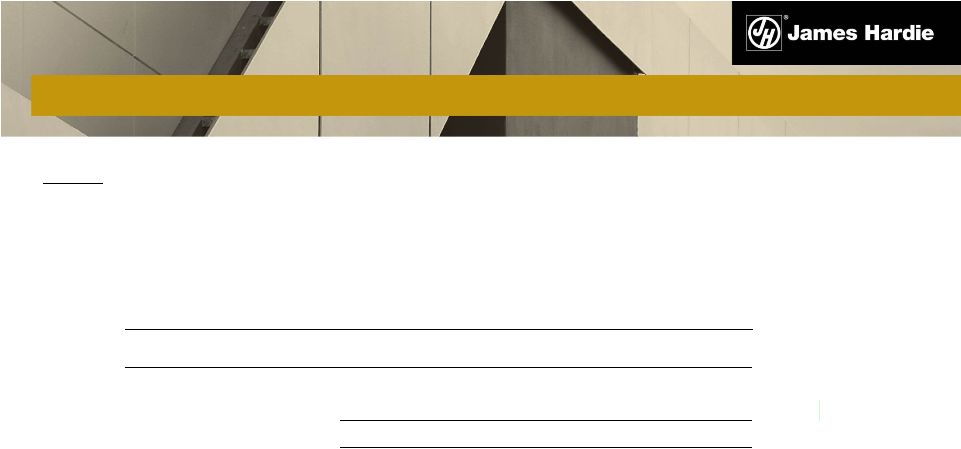 EBITDA–
is not a measure of financial performance under US GAAP and should not be
considered an alternative to, or more
meaningful
than,
income
from
operations,
net
income
or
cash
flows
as
defined
by
US
GAAP
or
as
a
measure
of
profitability or liquidity. Not all companies calculate EBITDA in the same manner
as James Hardie has and, accordingly, EBITDA may not be comparable with
other companies. Management has included information concerning EBITDA because
it believes that this data is commonly used by investors to evaluate the ability of
a company’s earnings from its core business operations to satisfy
its
debt,
capital
expenditure
and
working
capital
requirements.
57
NON-US GAAP FINANCIAL MEASURES (CONTINUED)
Q4
Q4
US$ Millions
FY 2012
FY 2011
FY 2012
FY 2011
EBIT
$ (7.4)
$ 50.8
$ 155.5
$ 104.7
Depreciation and amortisation
17.4
16.0
65.2
62.9
Adjusted EBITDA
$ 10.0
$ 66.8
$ 220.7
$ 167.6 |
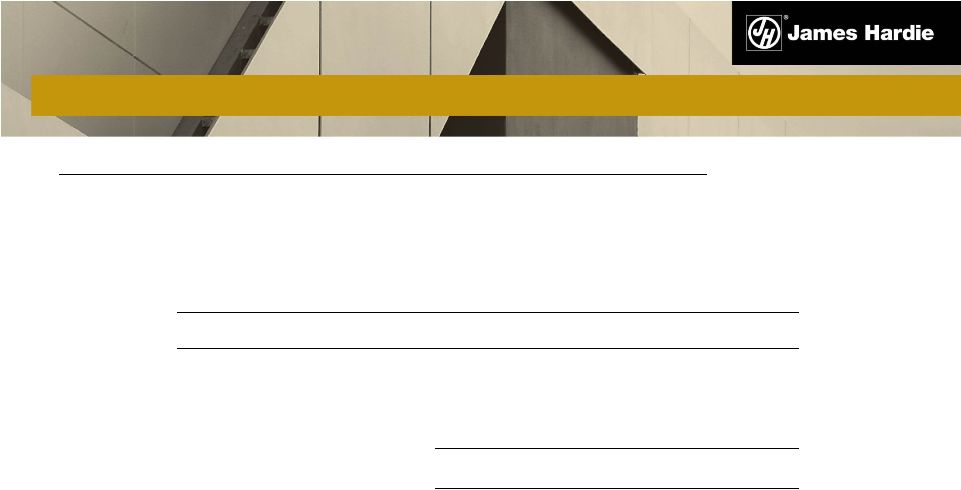 General
corporate
costs
excluding
ASIC
expenses
and
domicile
change
related
costs–
General
corporate
costs
excluding
ASIC
expenses
and
domicile
change
related
costs
is
not
a
measure
of
financial
performance
under
US
GAAP and should not be considered to be more meaningful than general corporate
costs. Management has included these financial measures to provide investors
with an alternative method for assessing its operating results in a manner
that is focussed on the performance of its ongoing operations and provides useful
information regarding its financial condition and results of operations.
Management uses these non-US GAAP measures for the same purposes. 58
NON-US GAAP FINANCIAL MEASURES (CONTINUED)
Q4
US$ Millions
FY 2011
FY 2011
General corporate costs
$ 6.8
$ 5.8
$ 33.9
$ 26.9
Excluding:
ASIC related (expenses) recoveries
(0.1)
(0.8)
(1.1)
8.7
Domicile change related costs
-
-
-
(1.8)
General corporate costs excluding ASIC
expenses and domicile change related costs
$ 6.7
$ 5.0
$ 32.8
$ 33.8
FY 2012
Q4
FY 2012 |
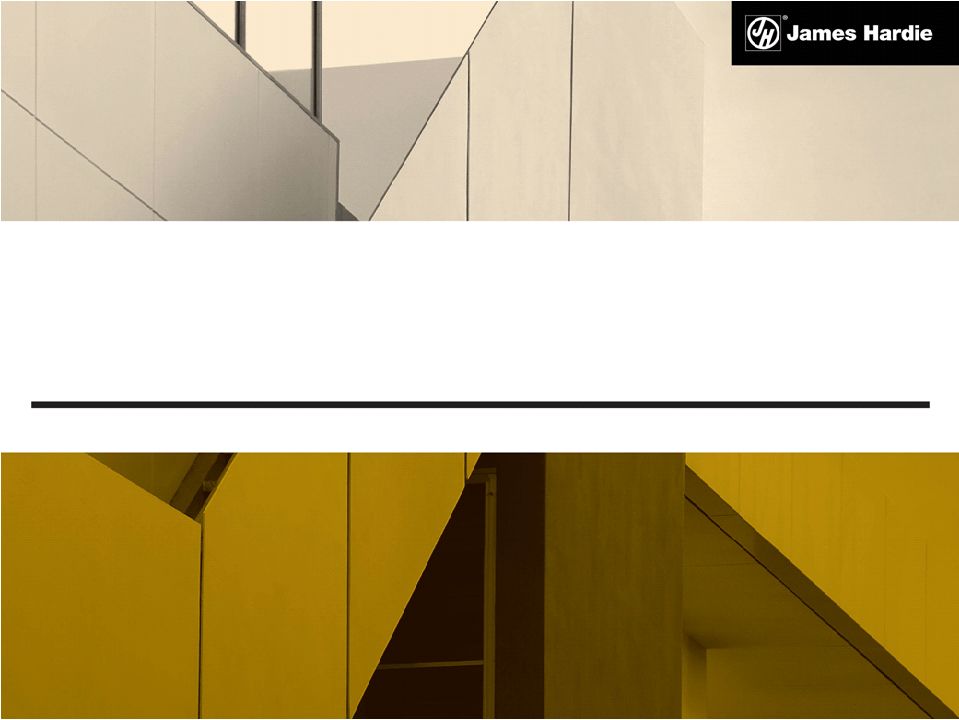 Q4 FY12
MANAGEMENT PRESENTATION 21 May 2012 |